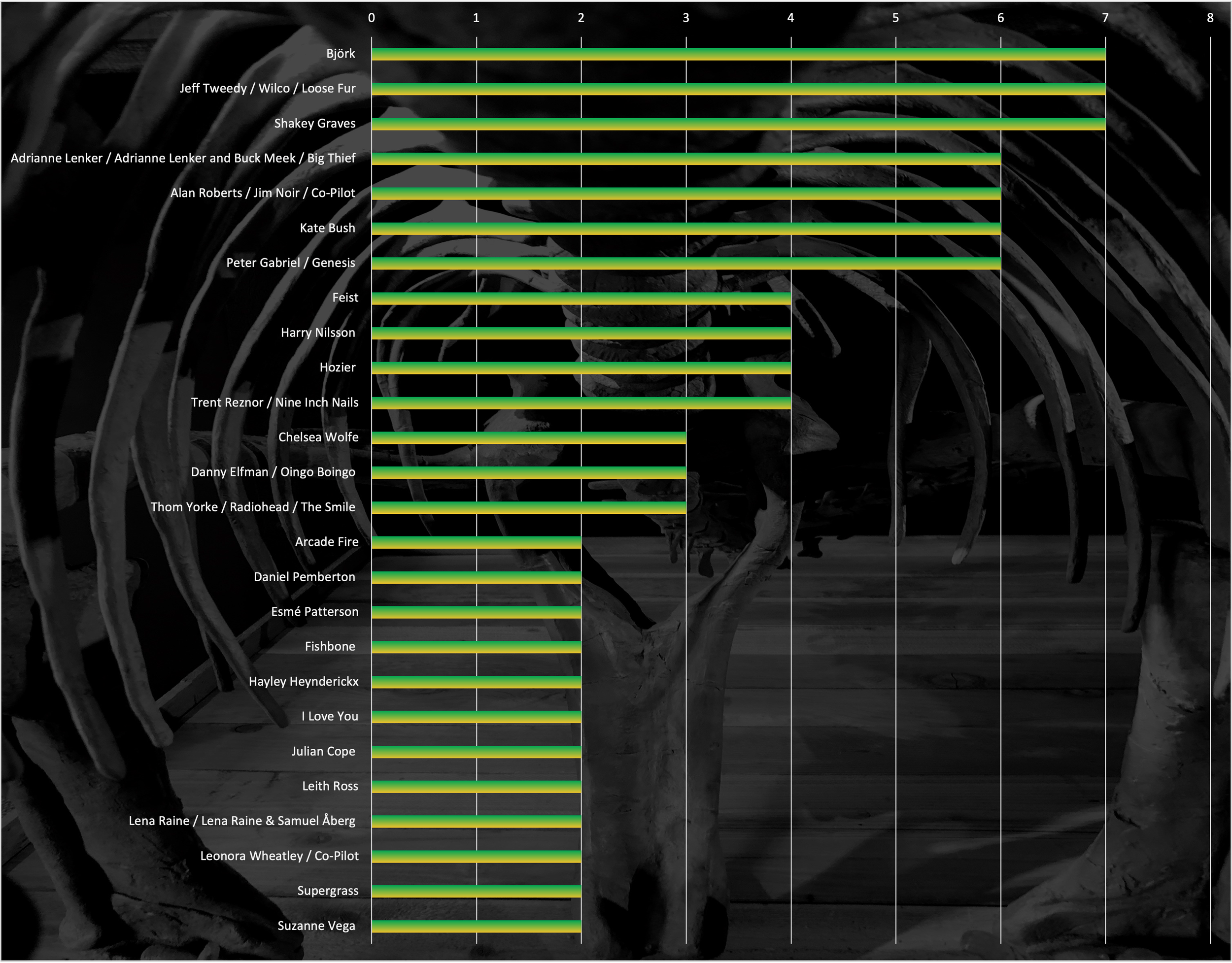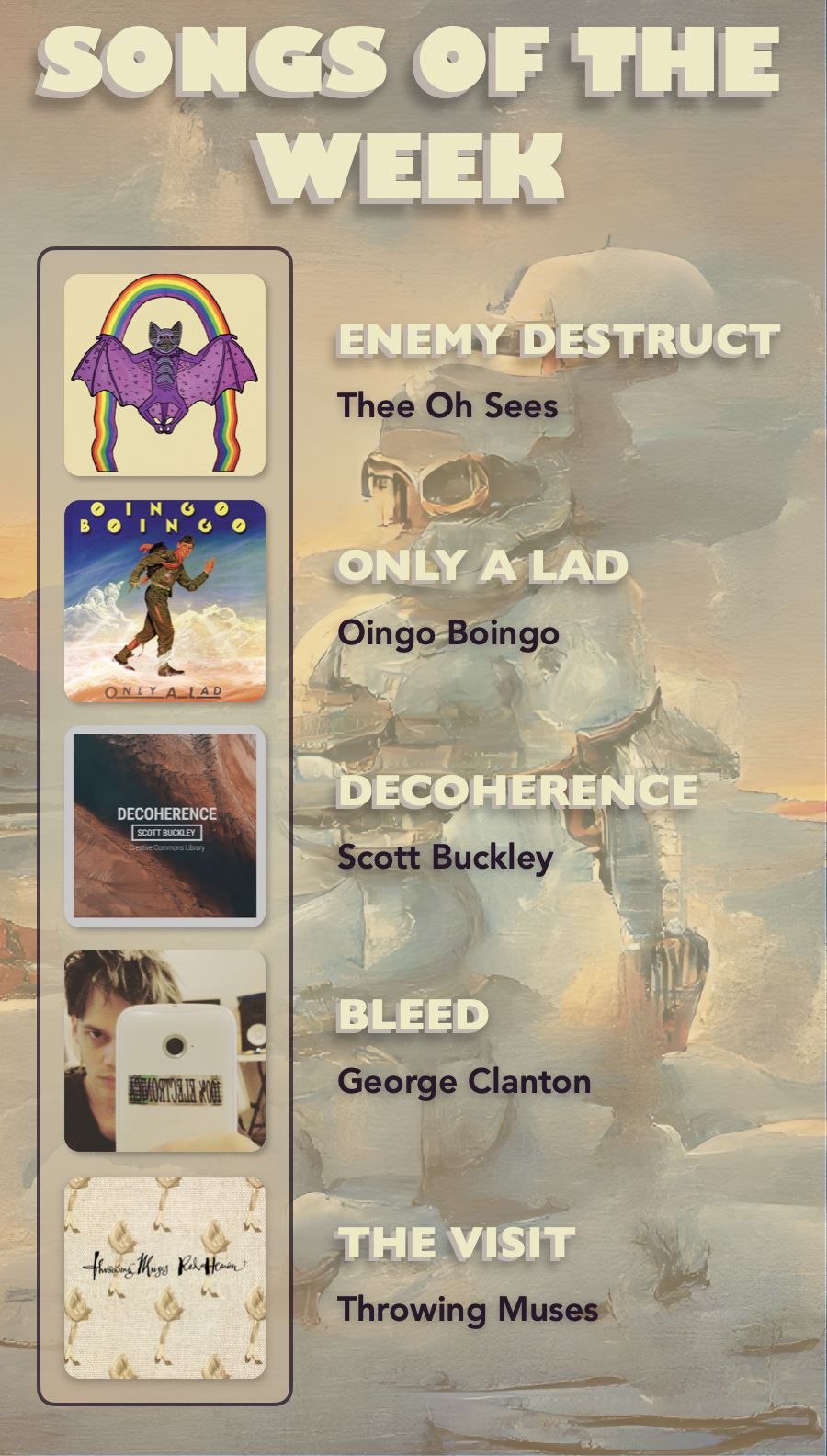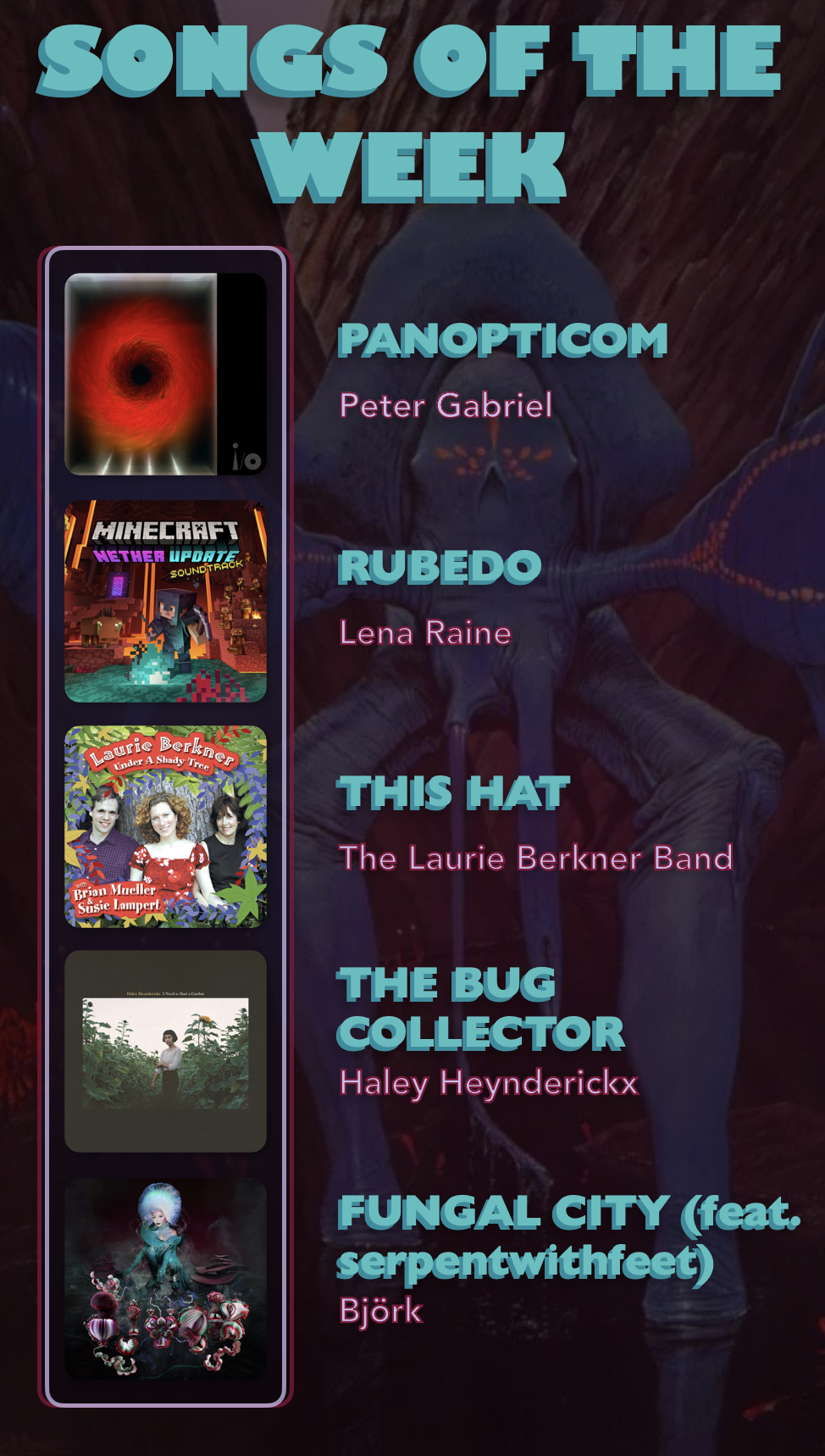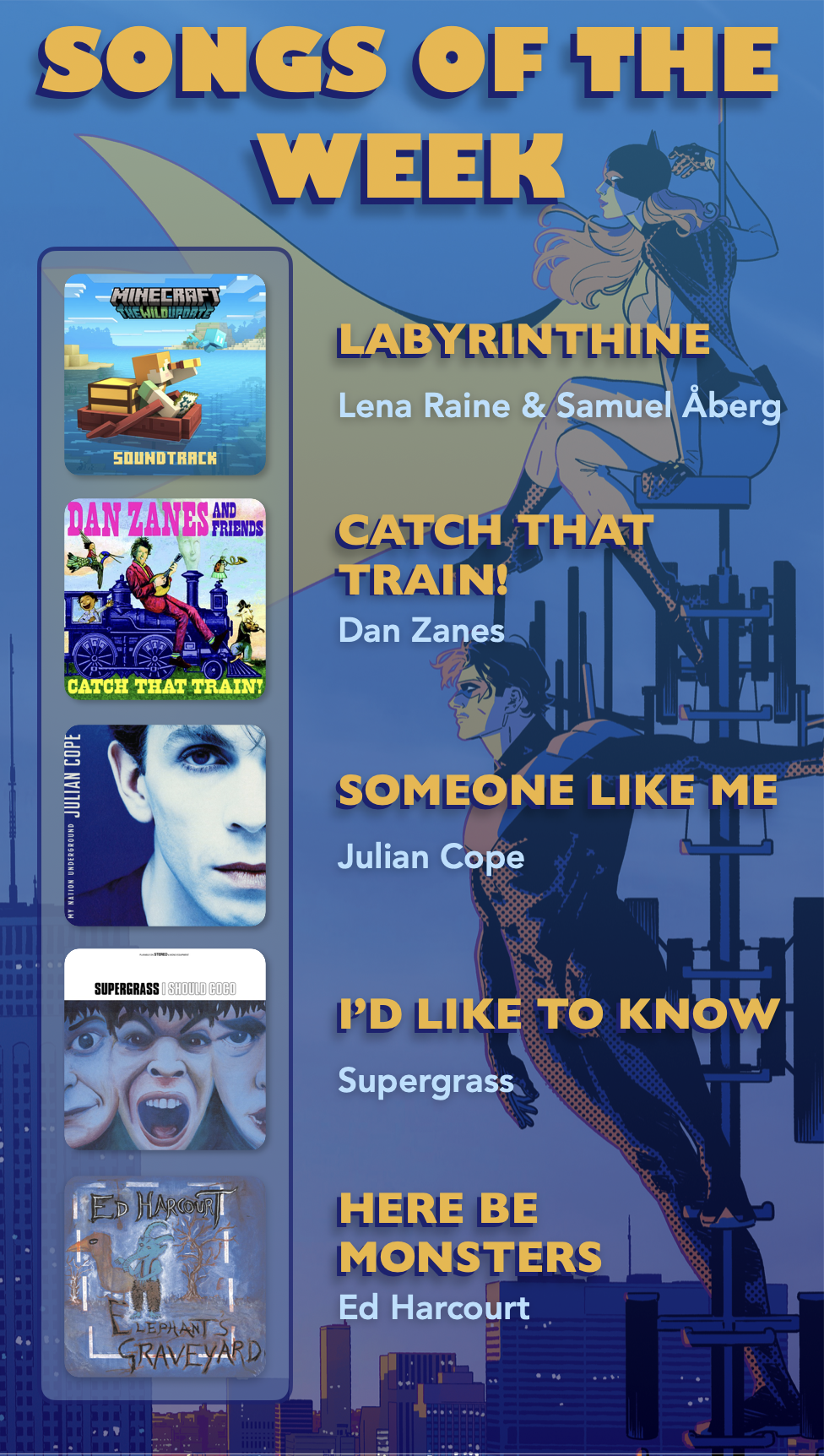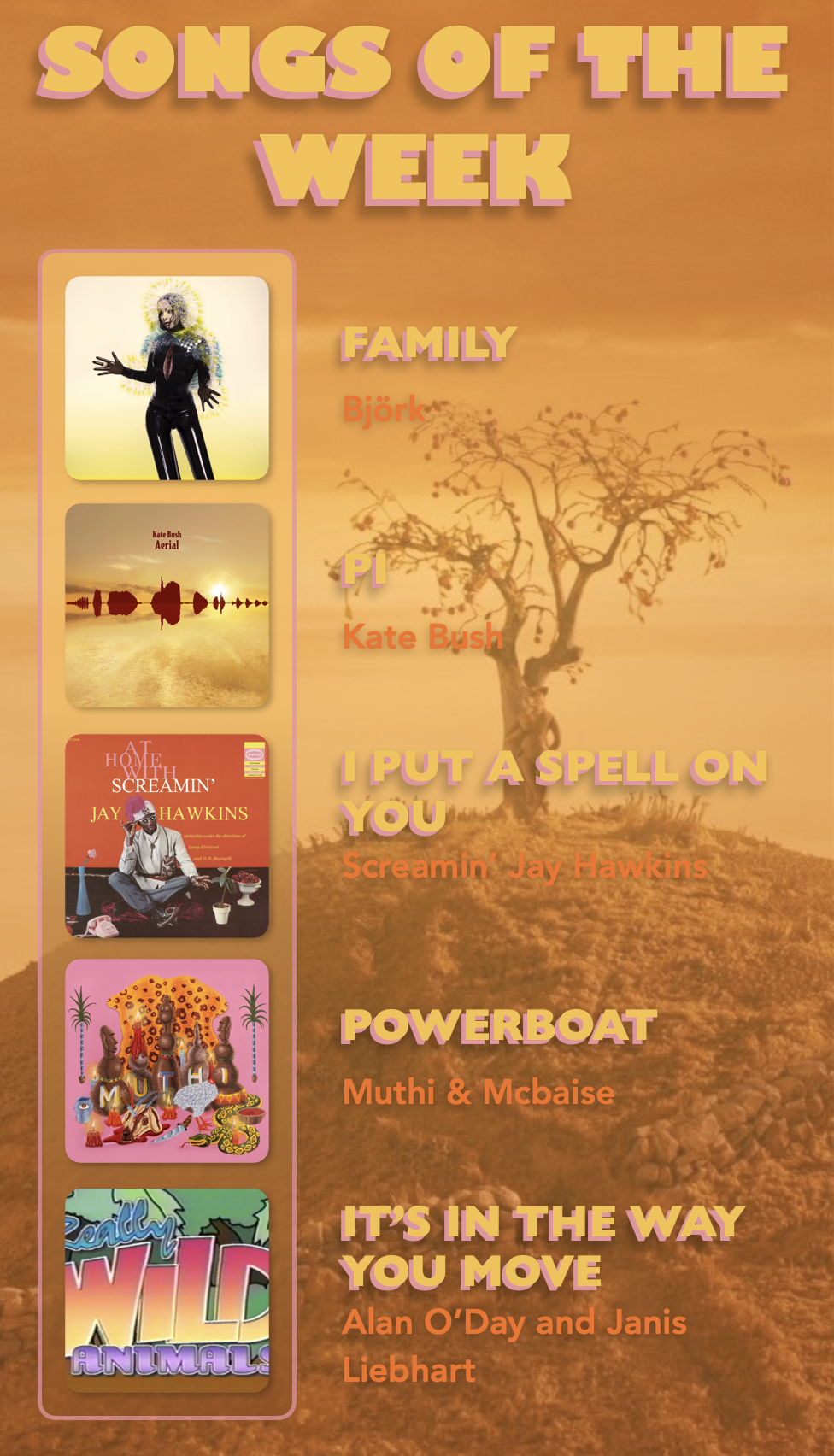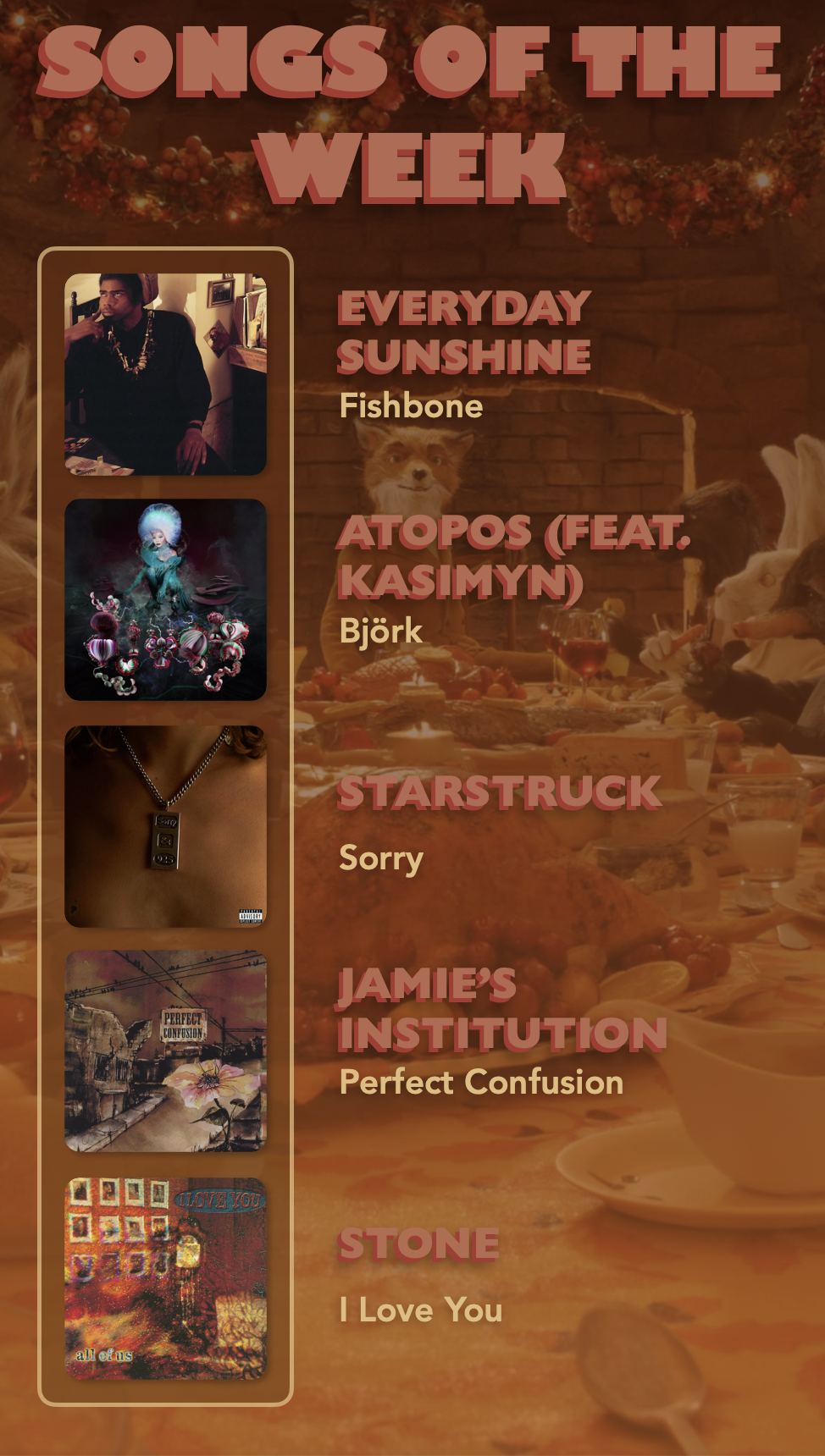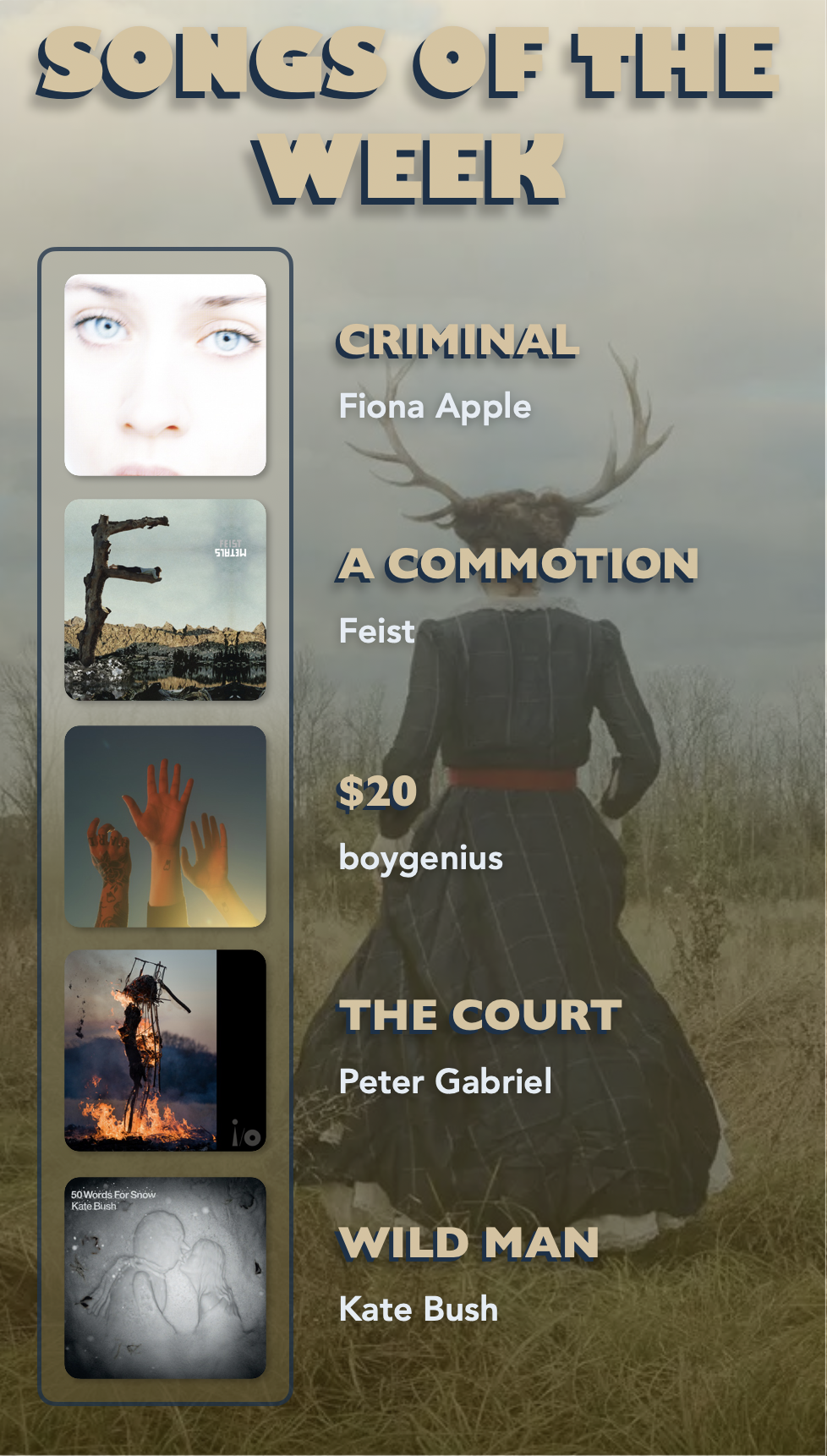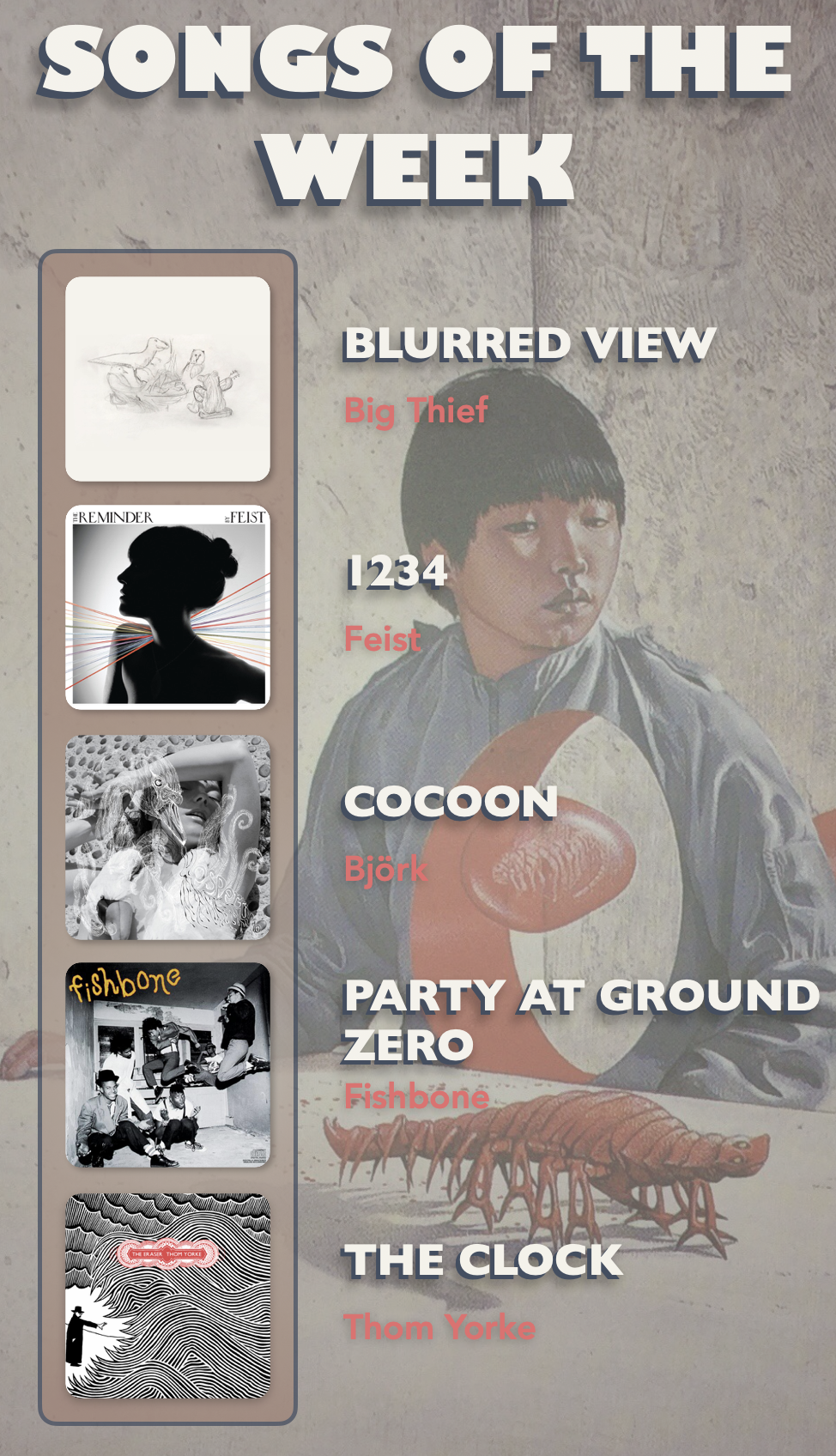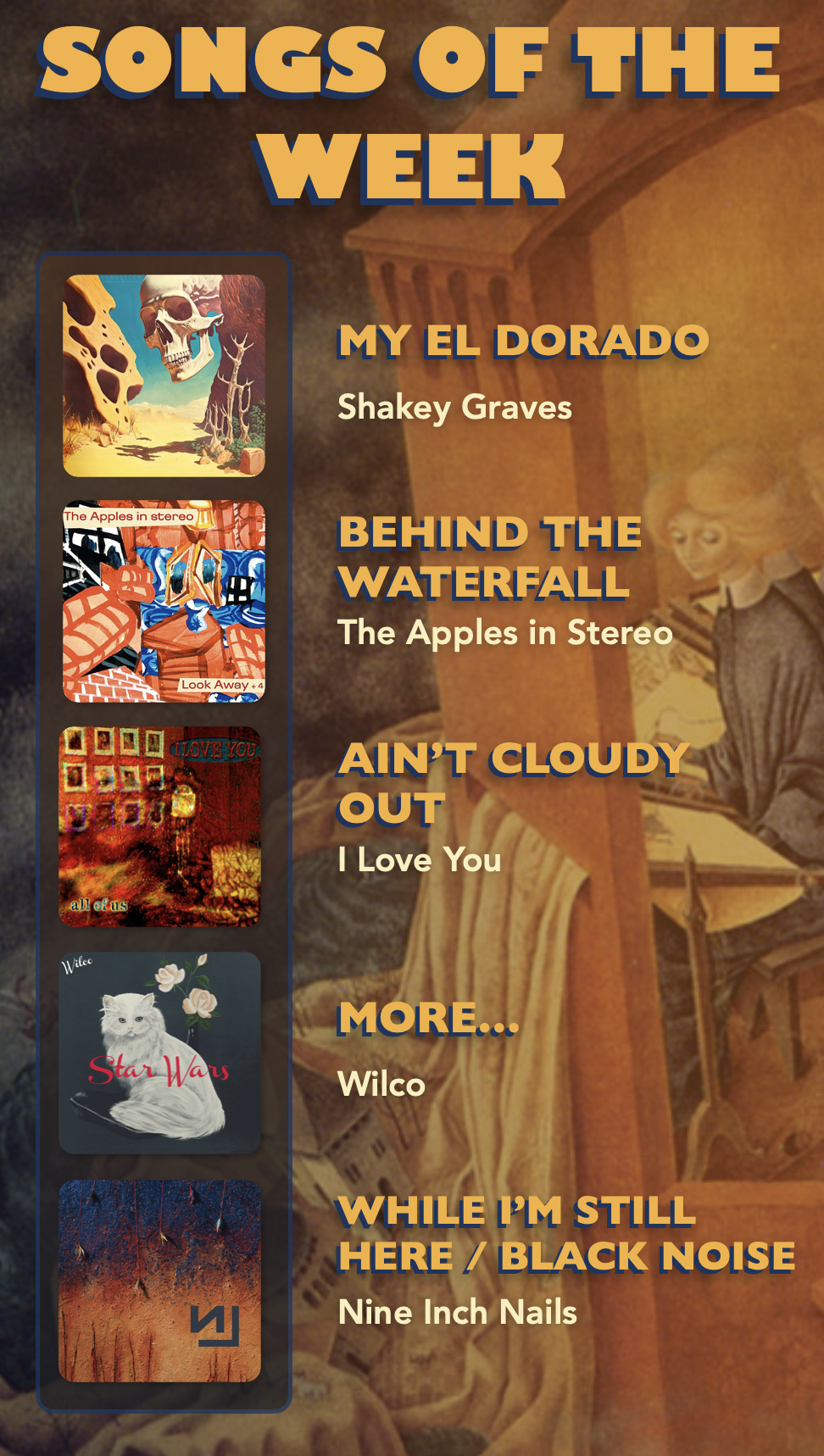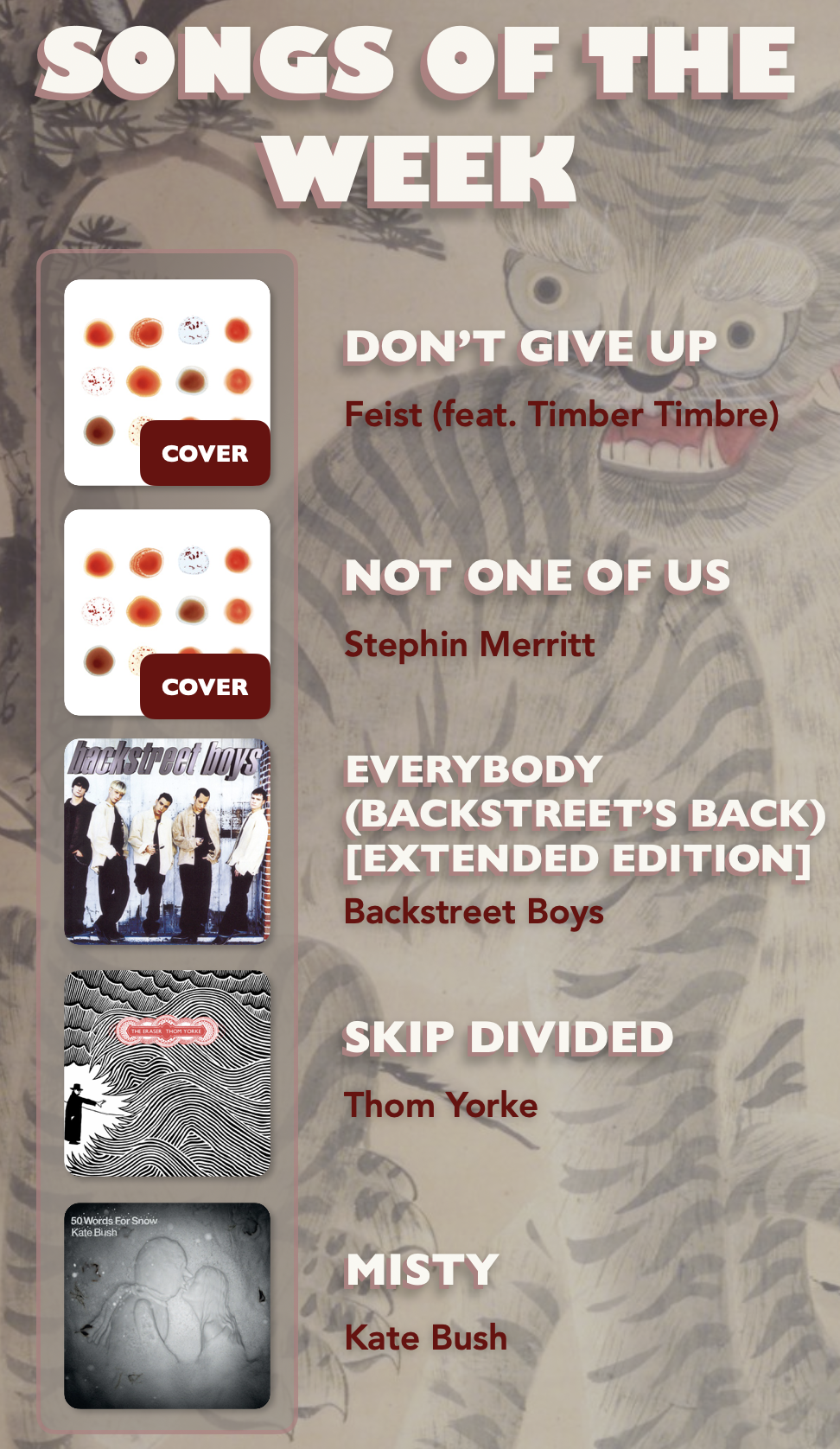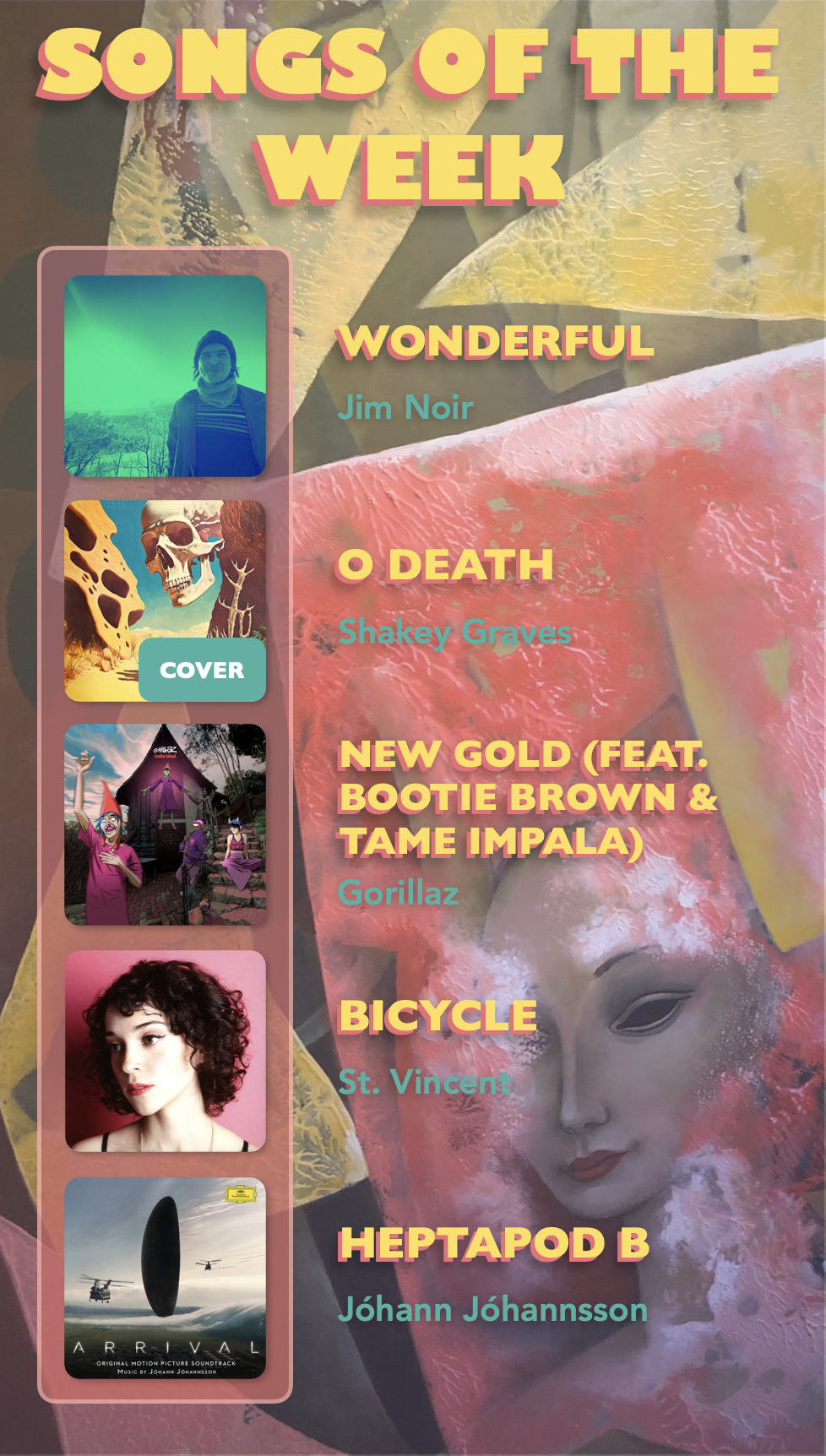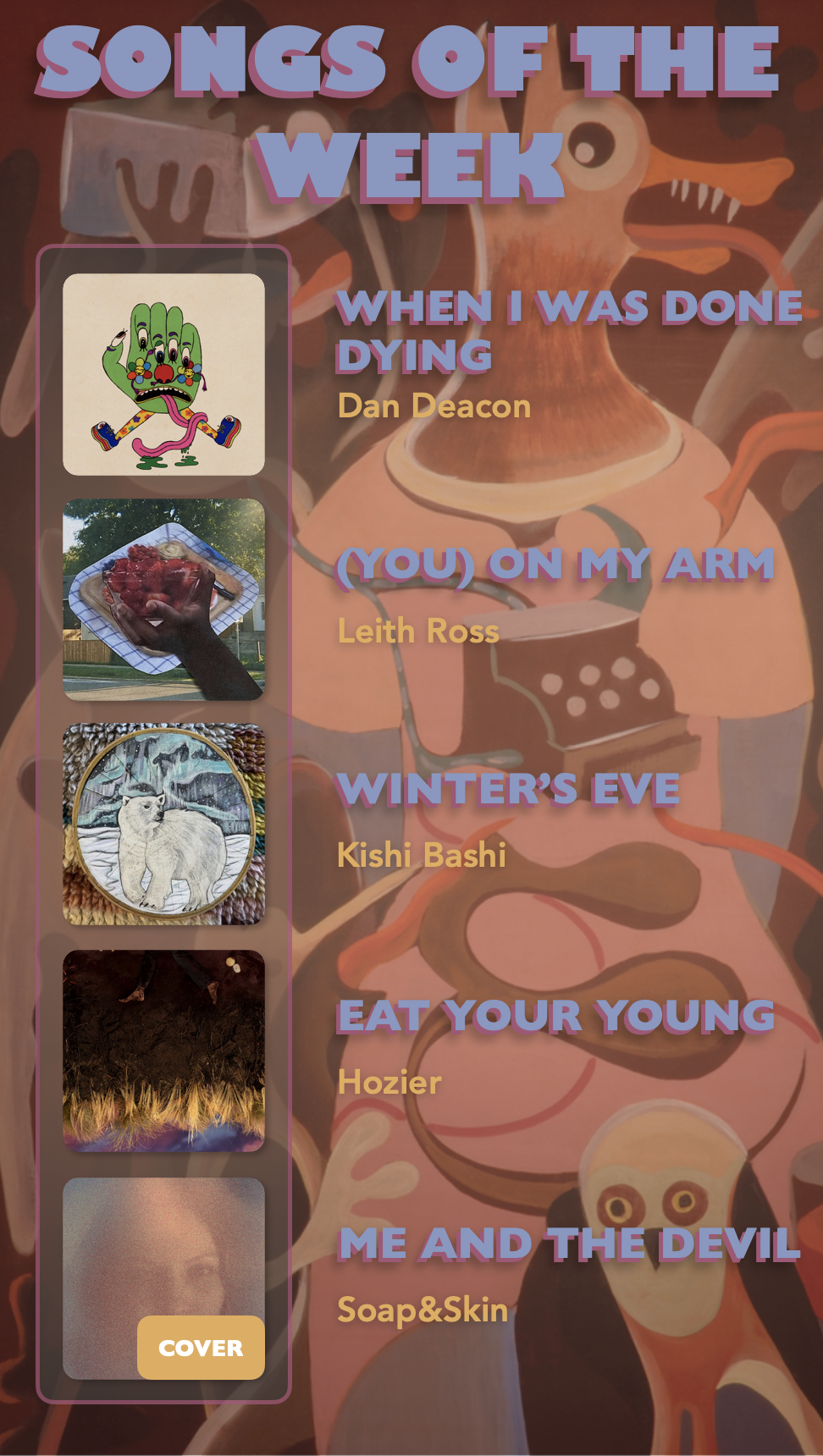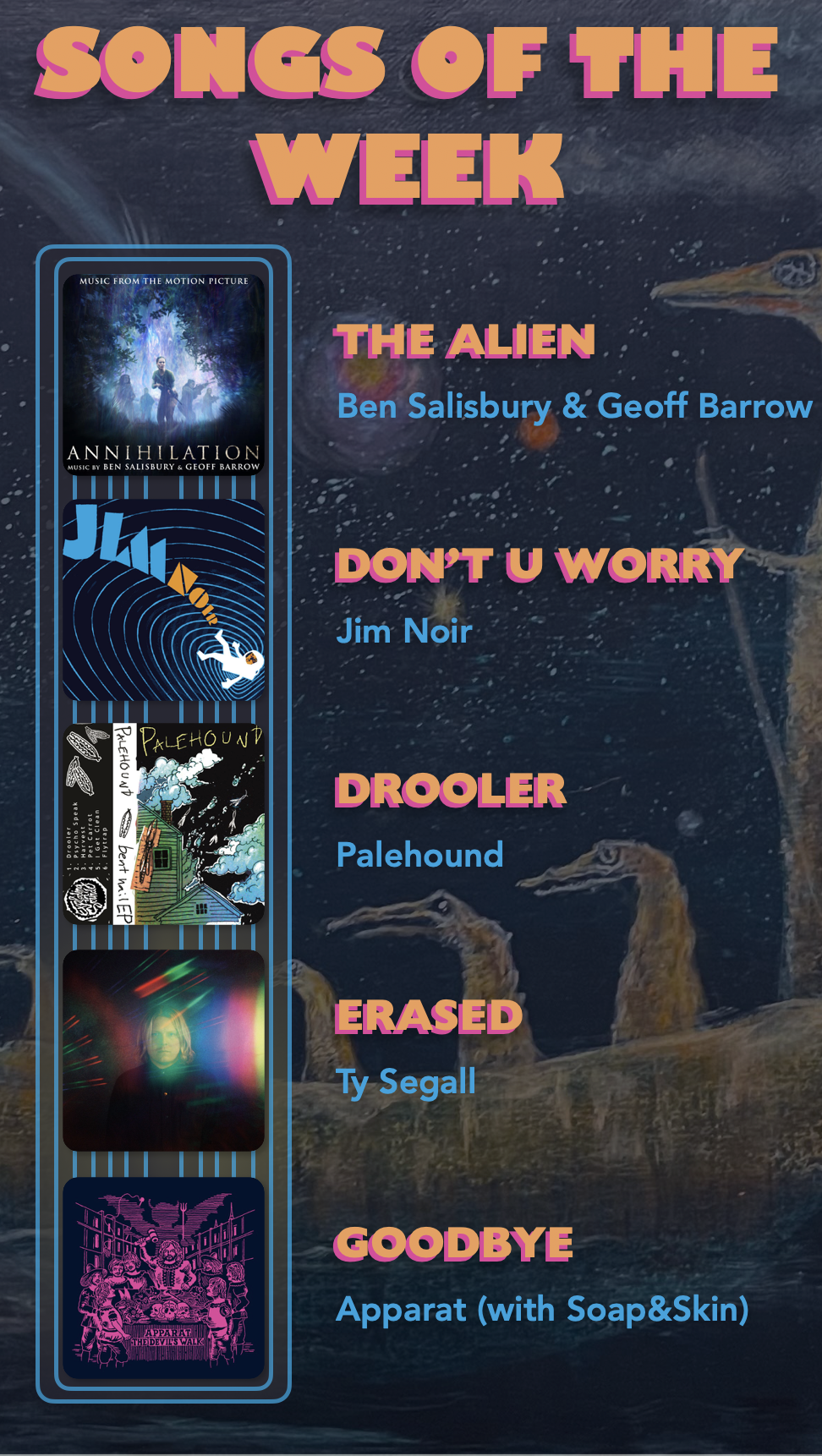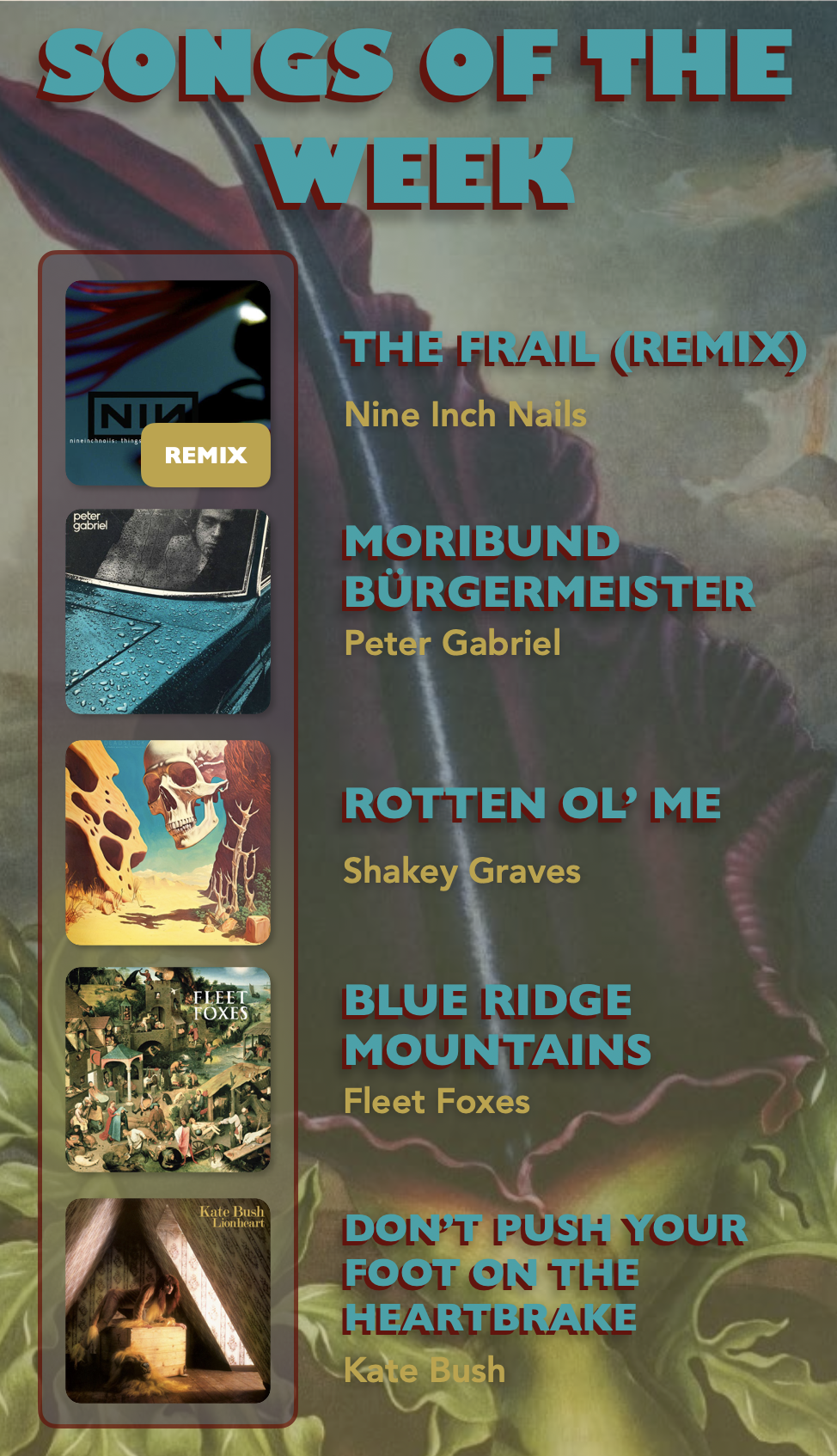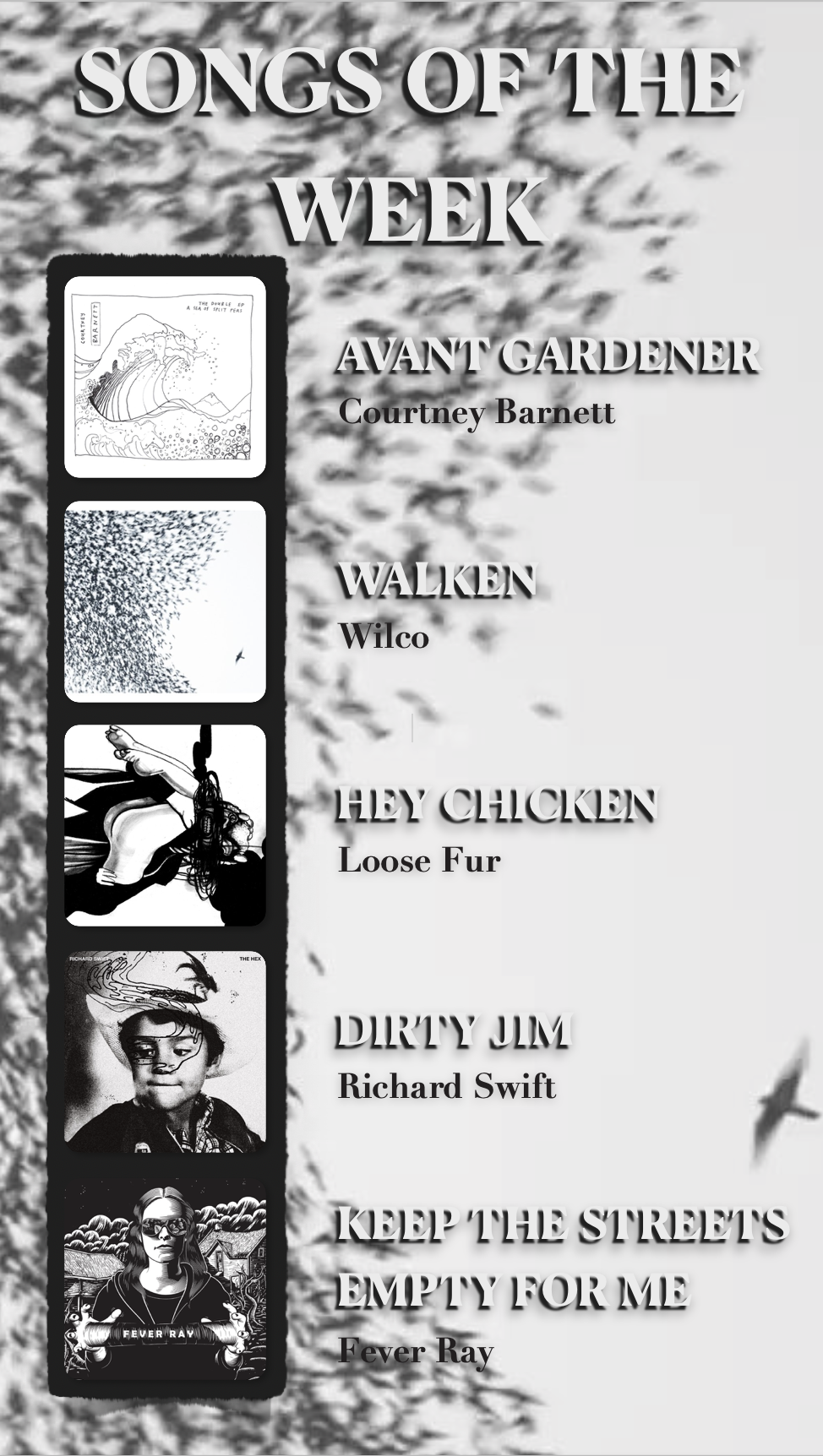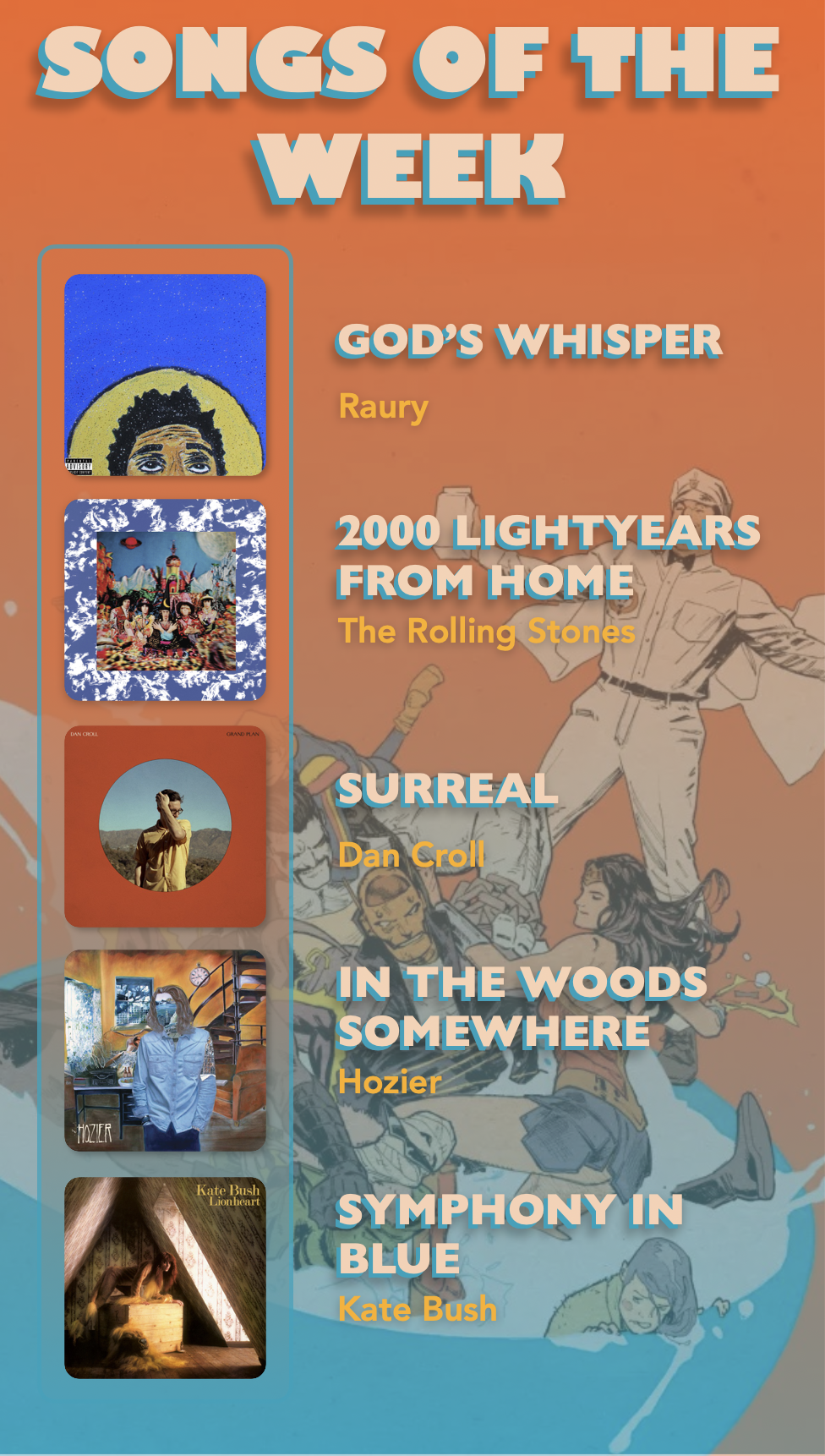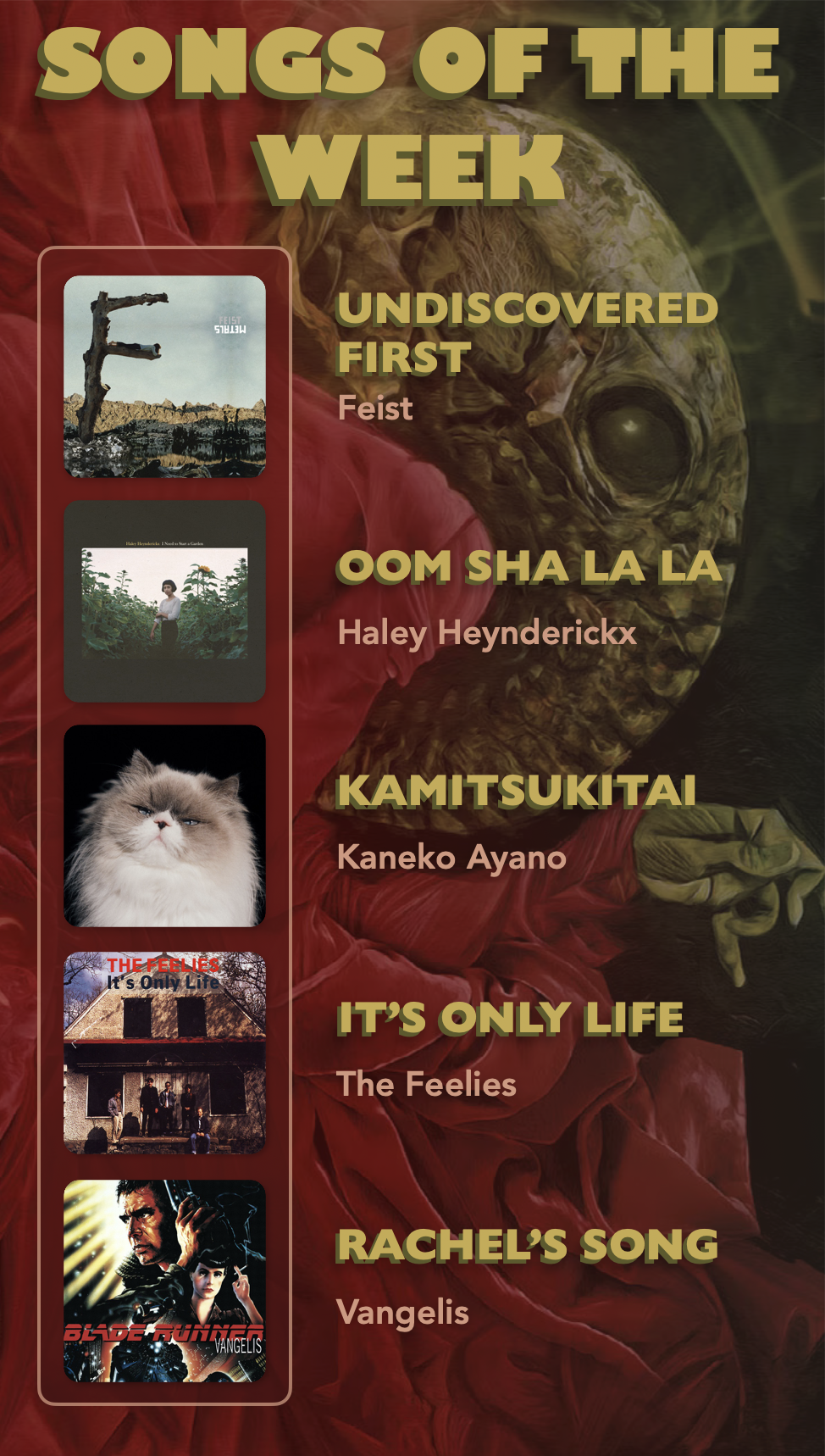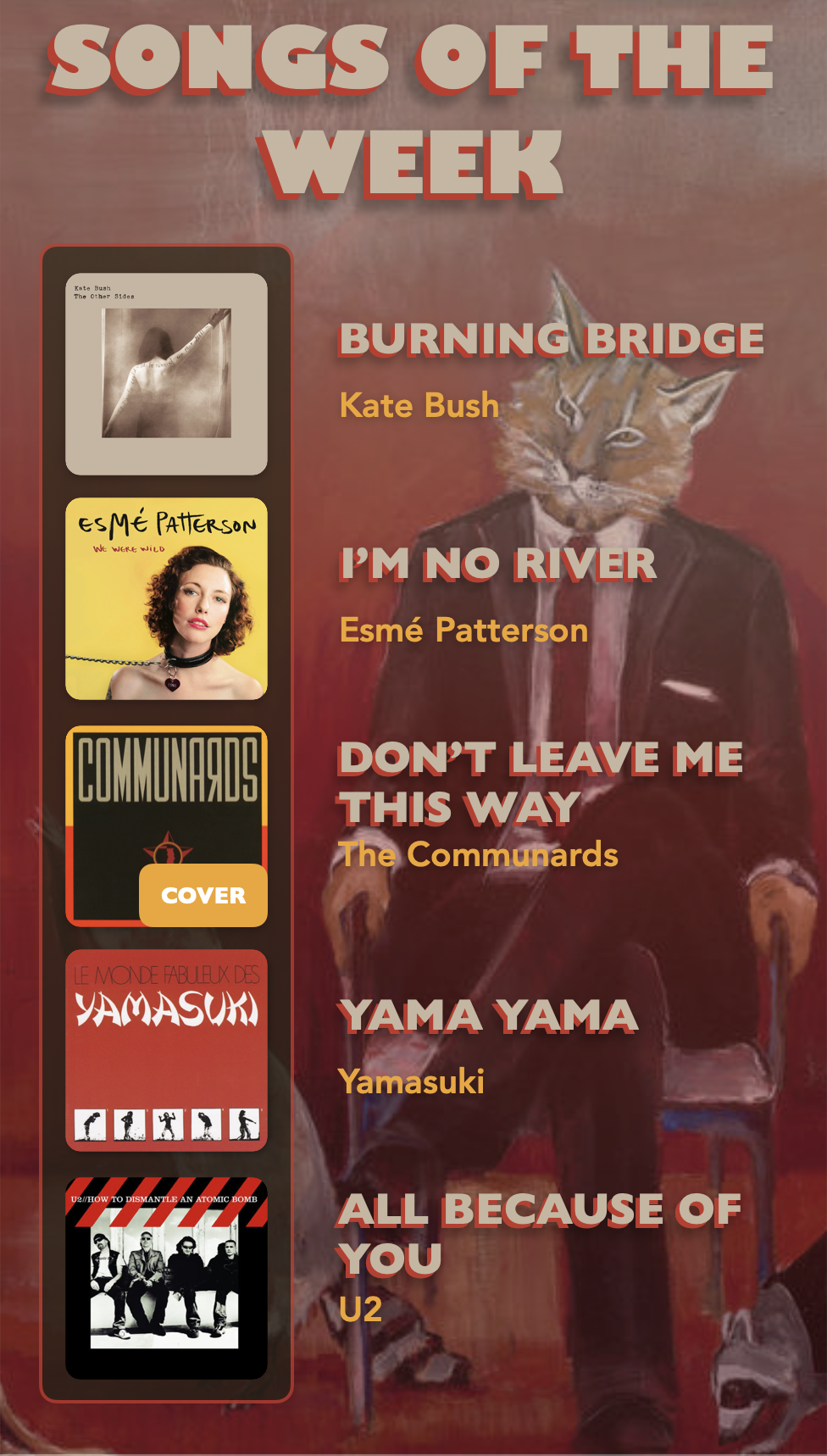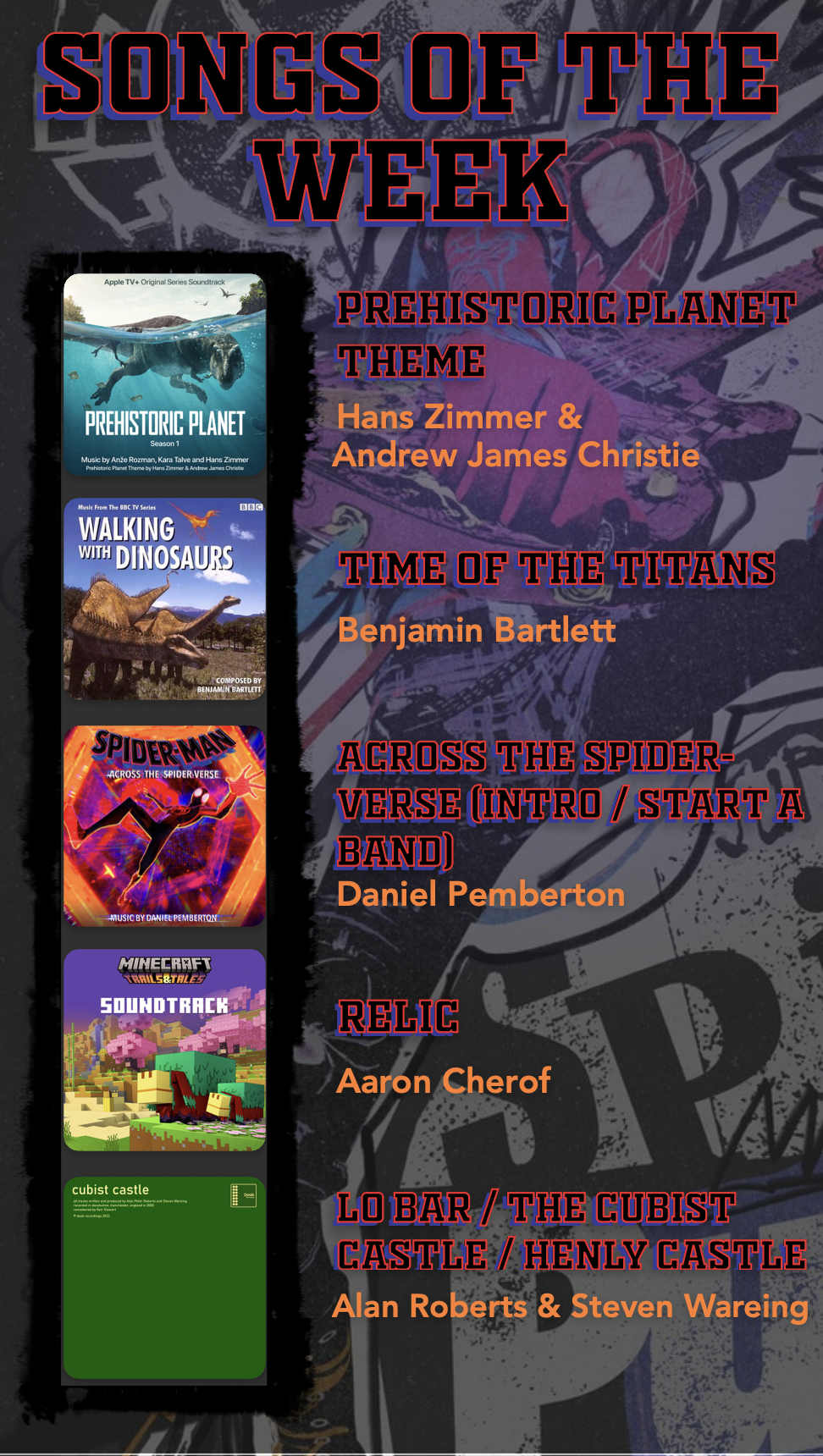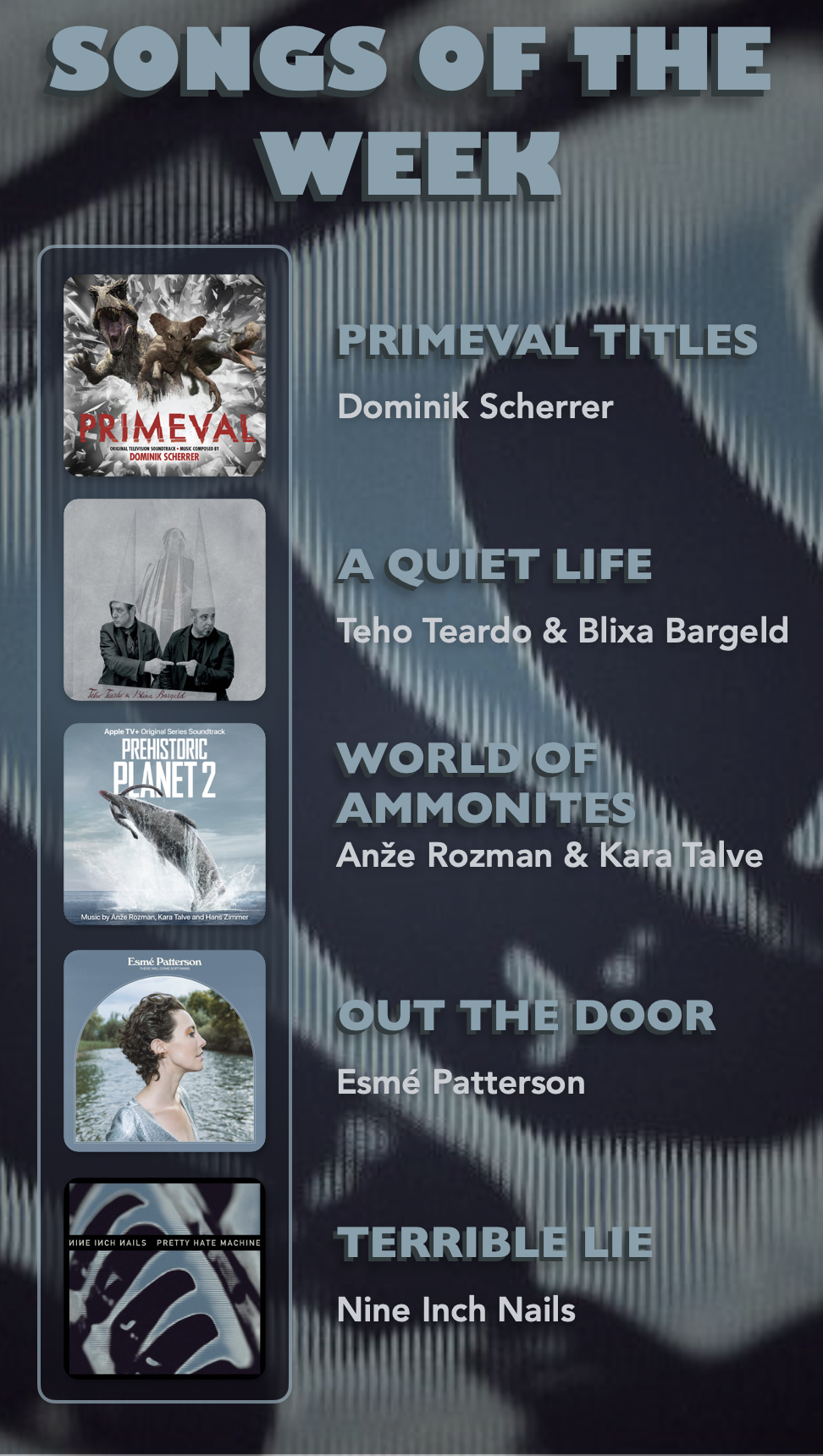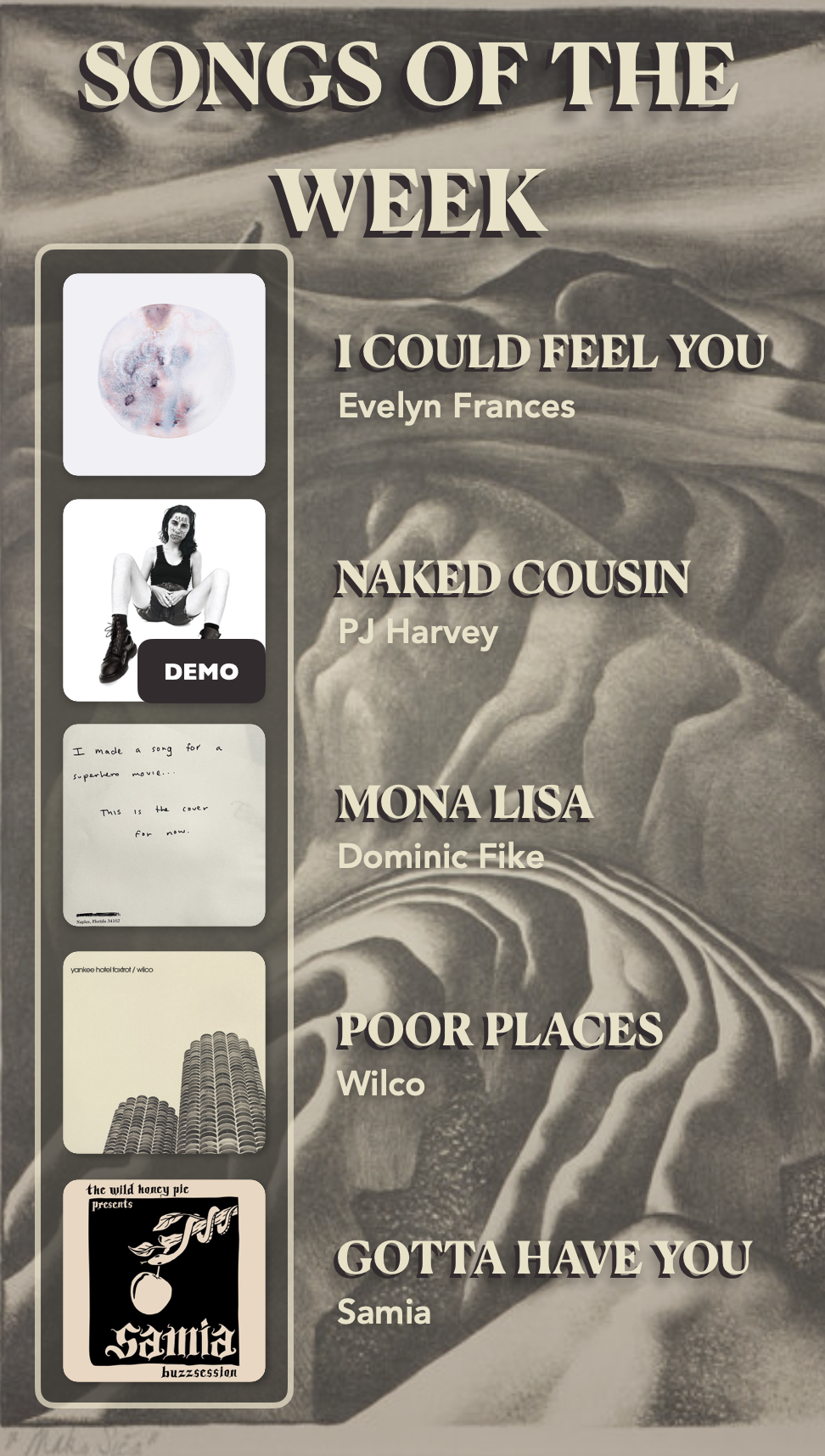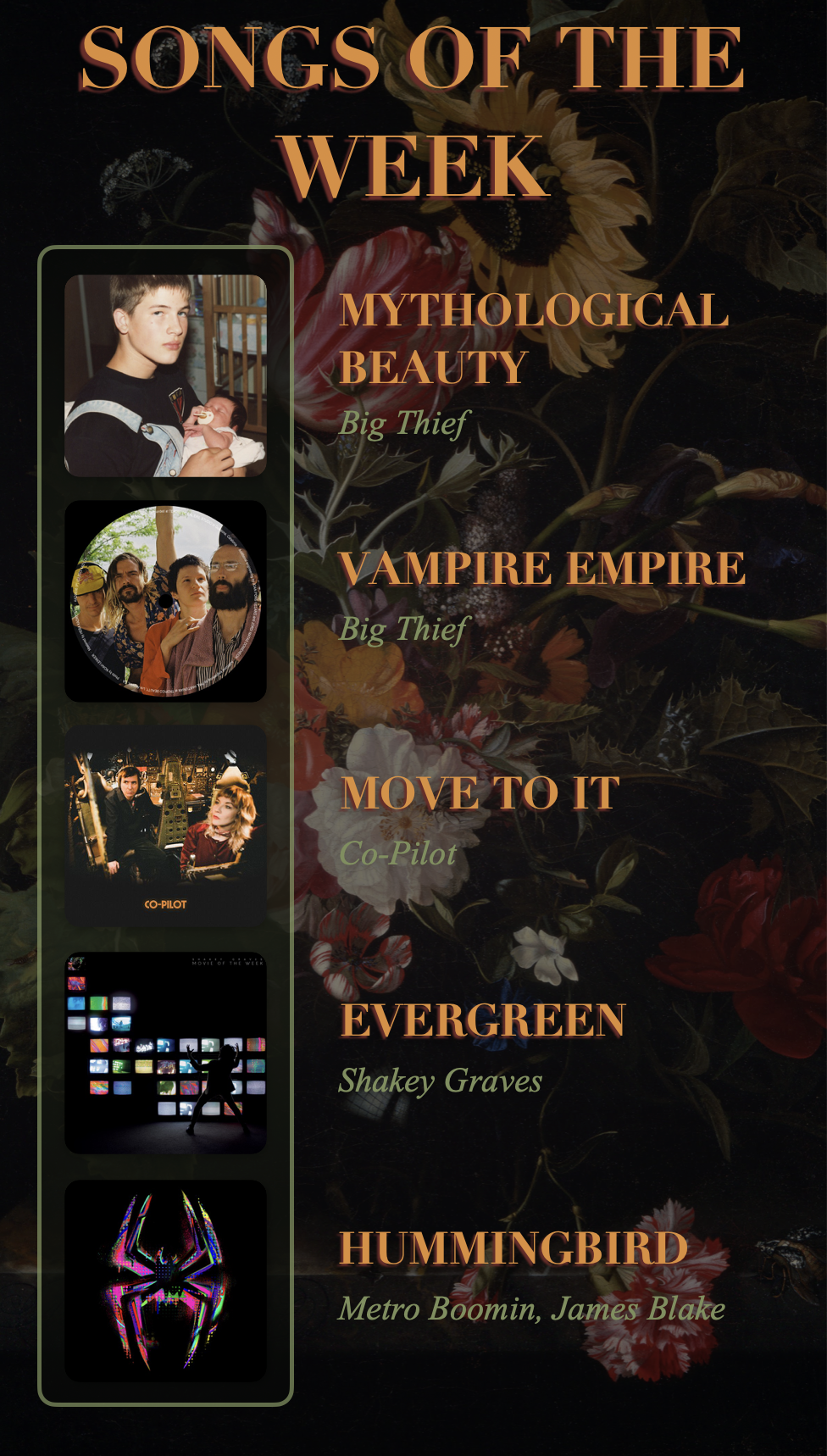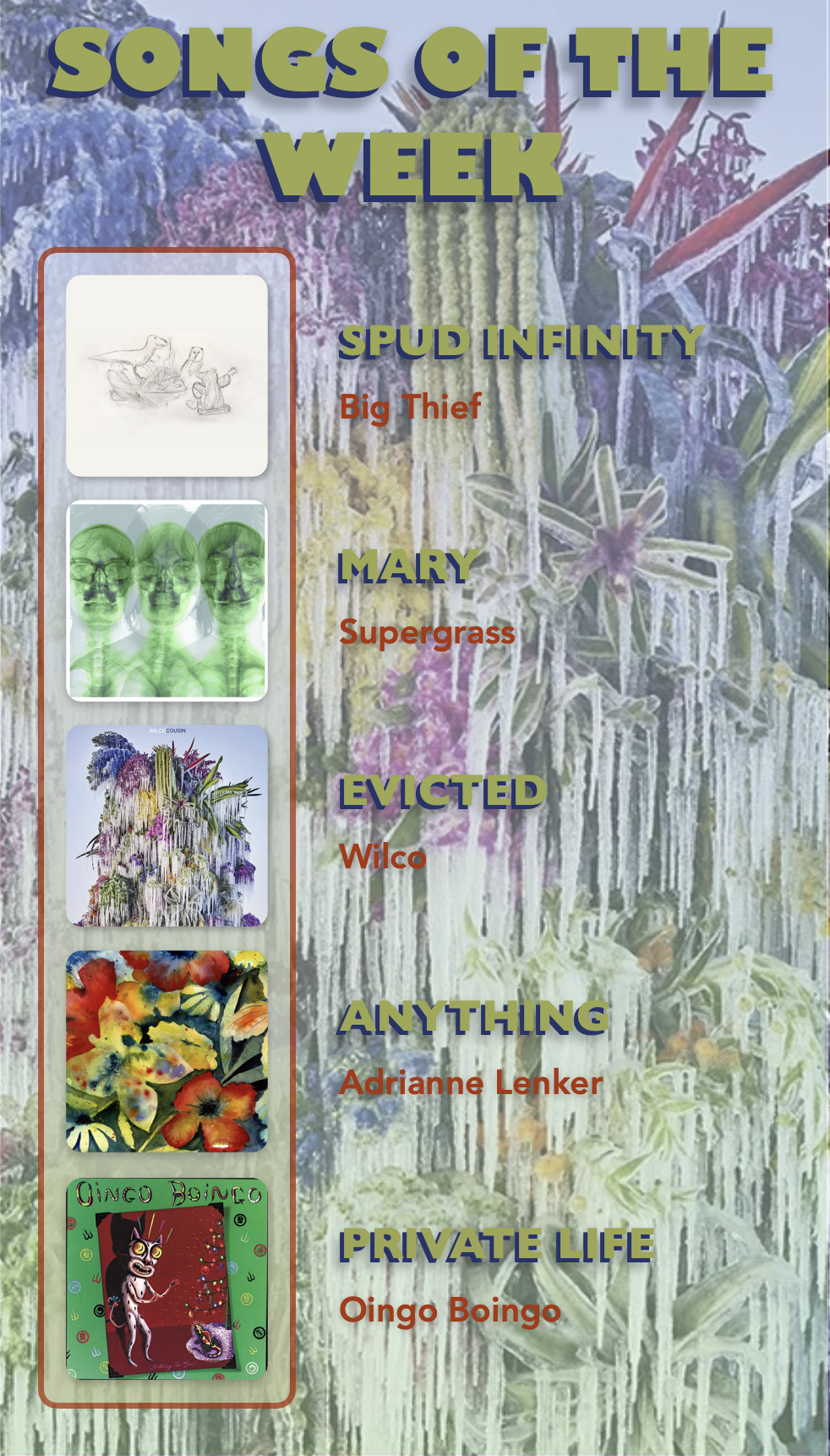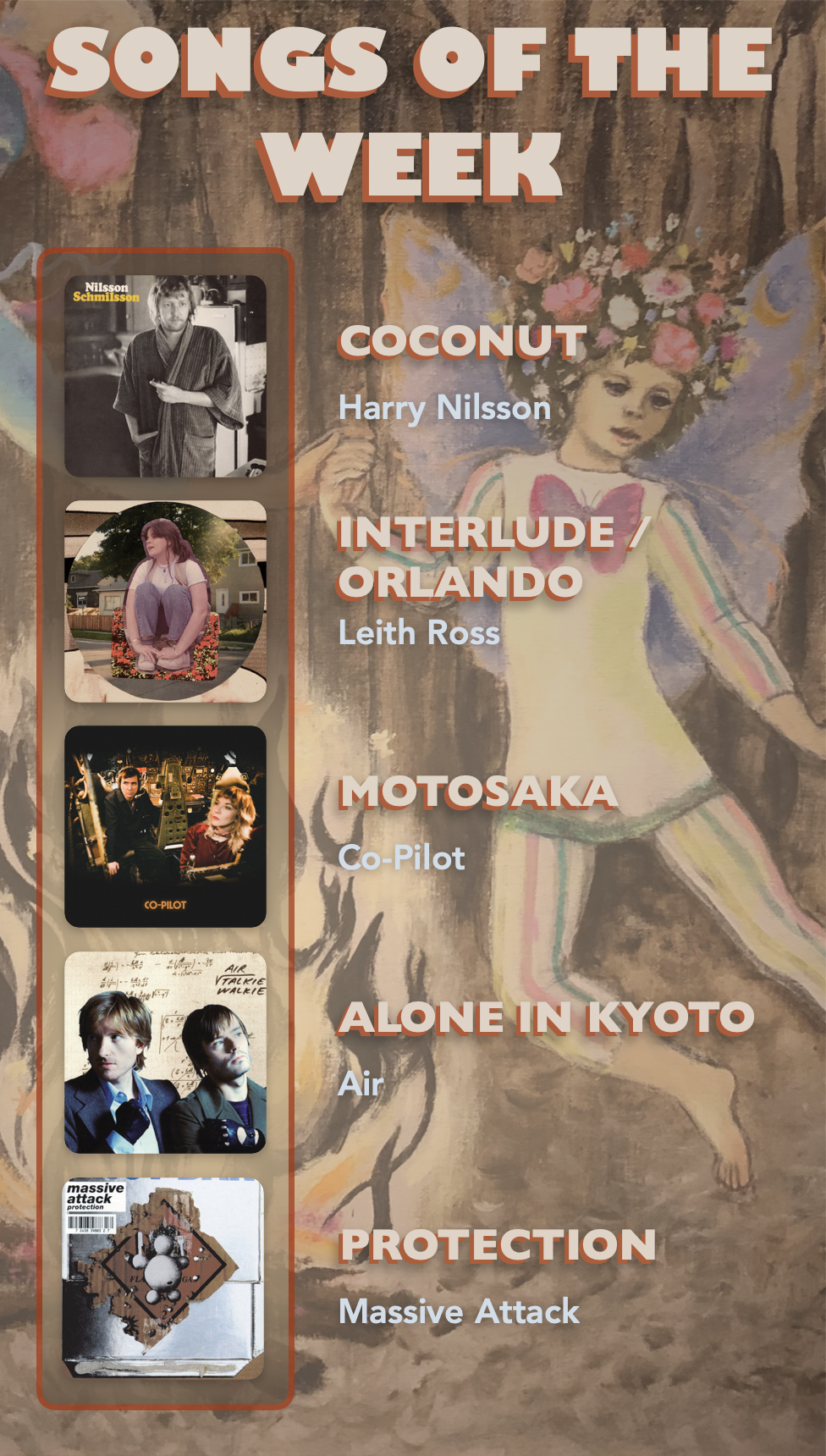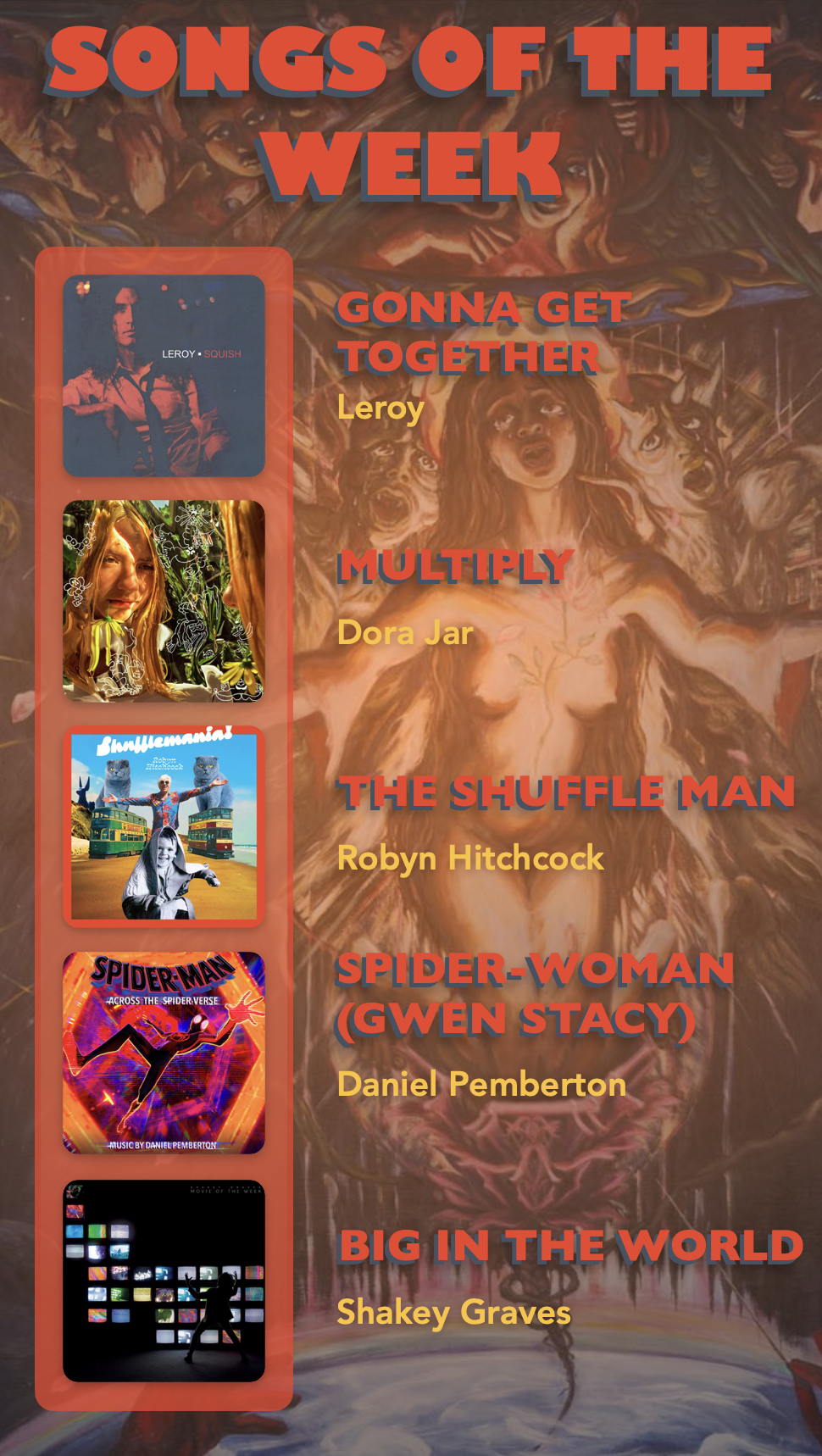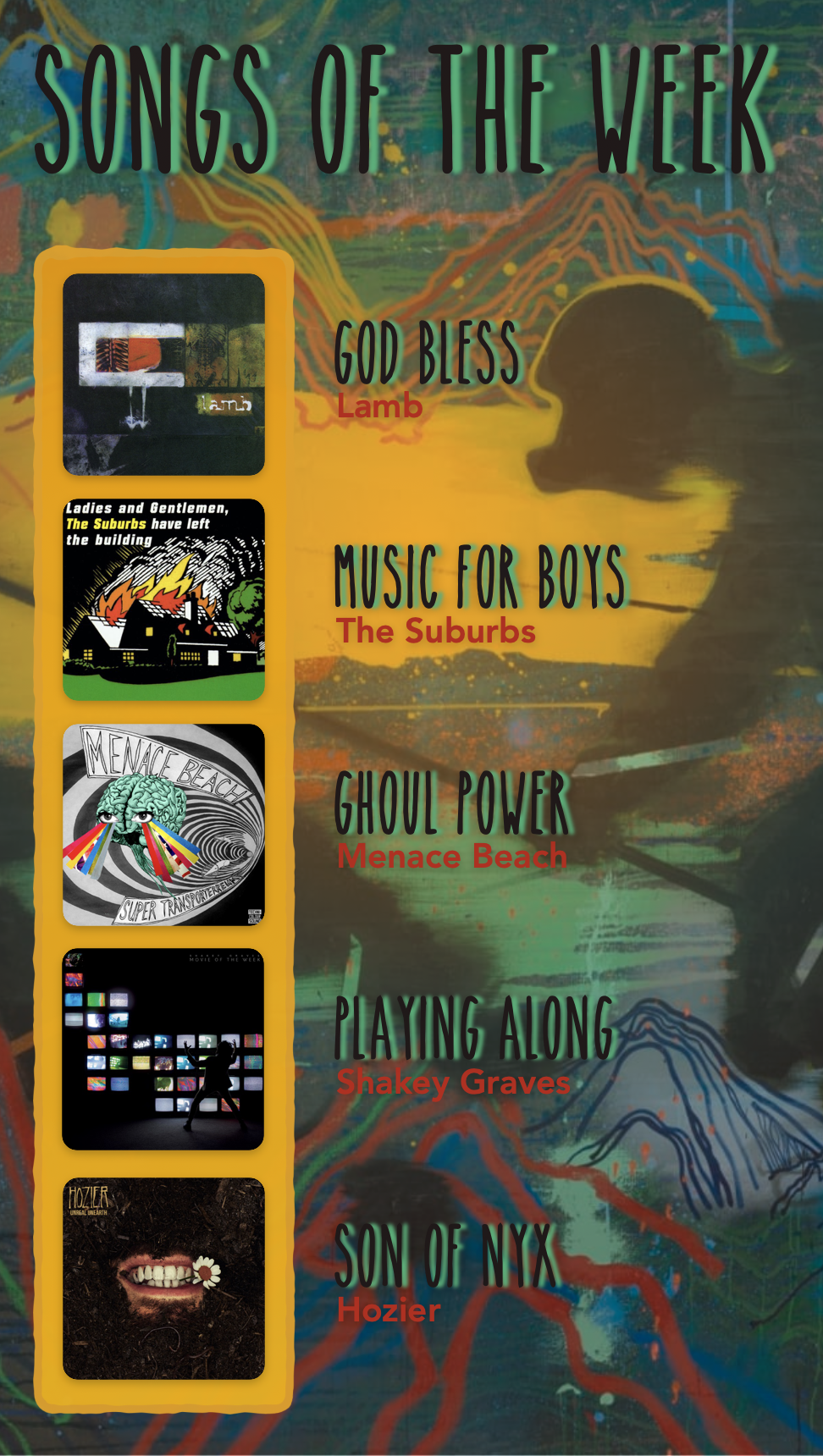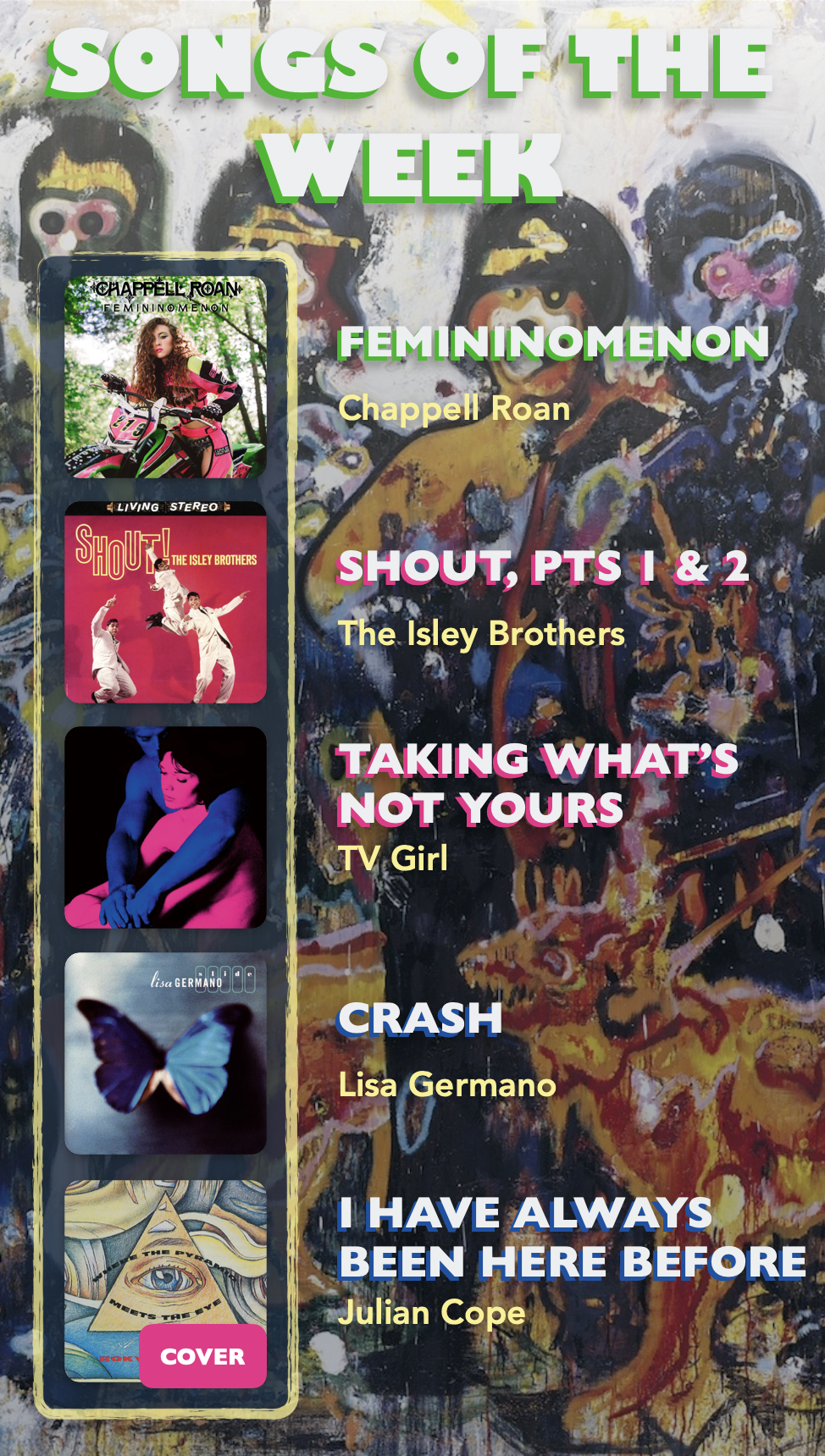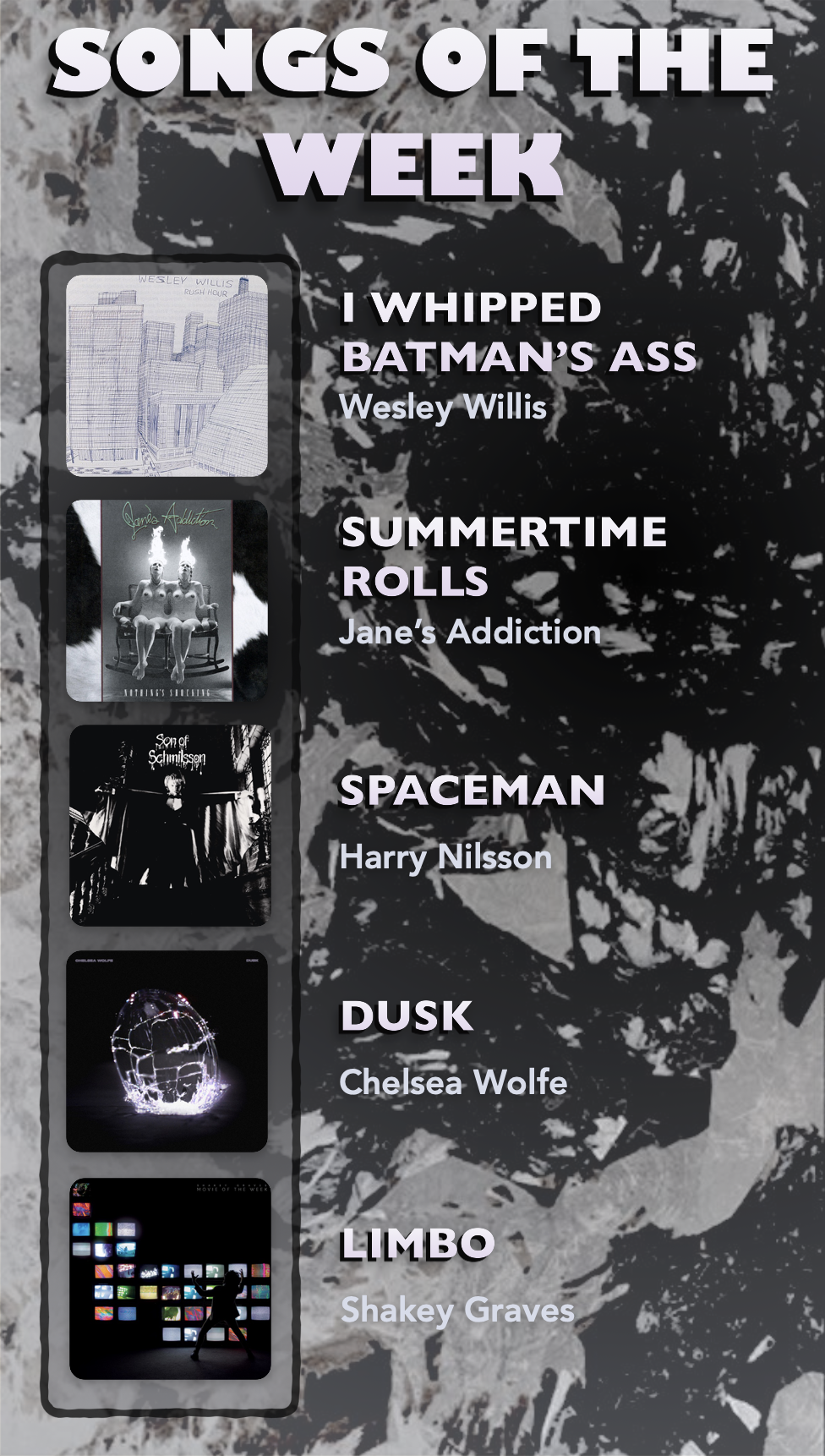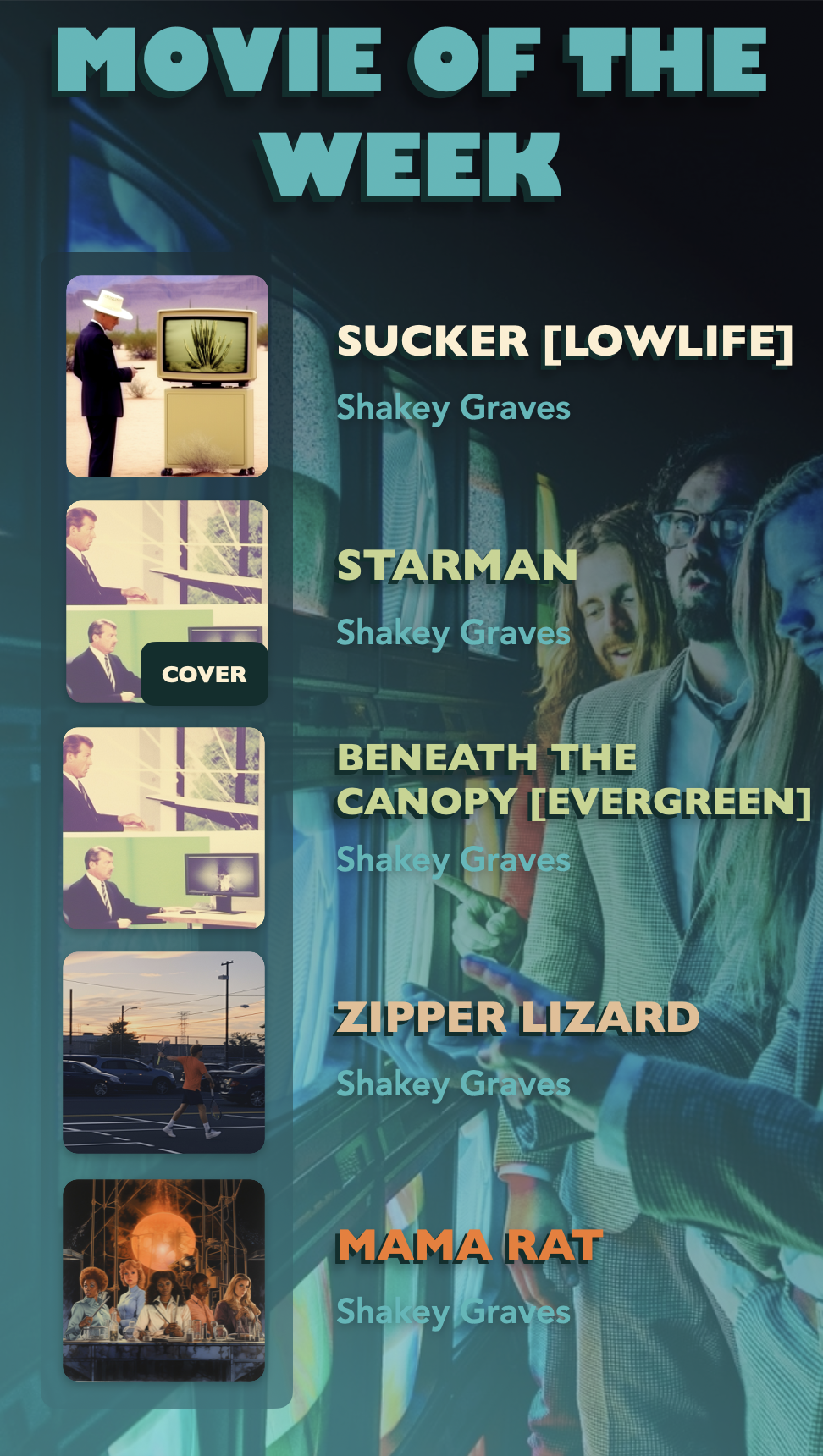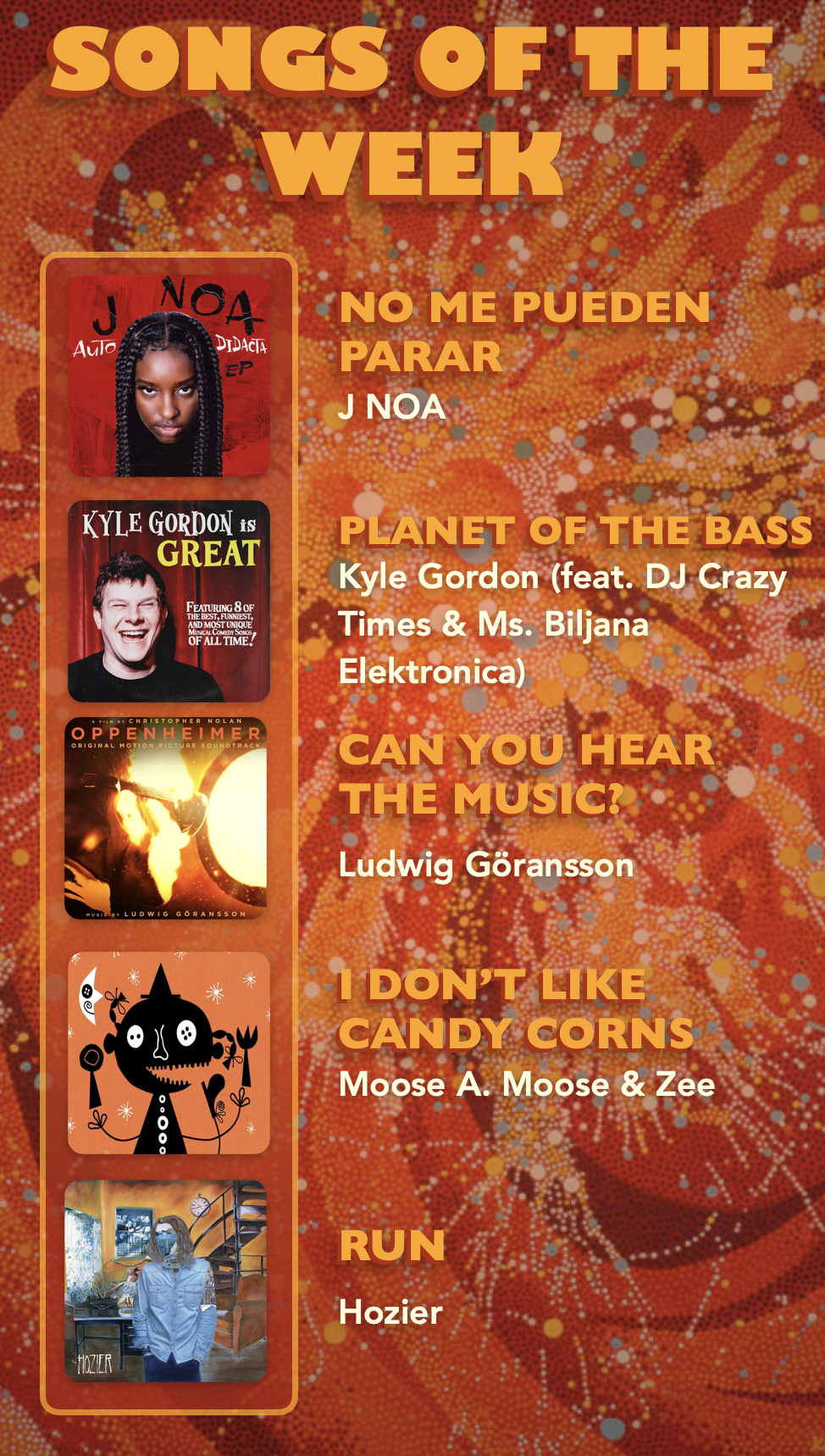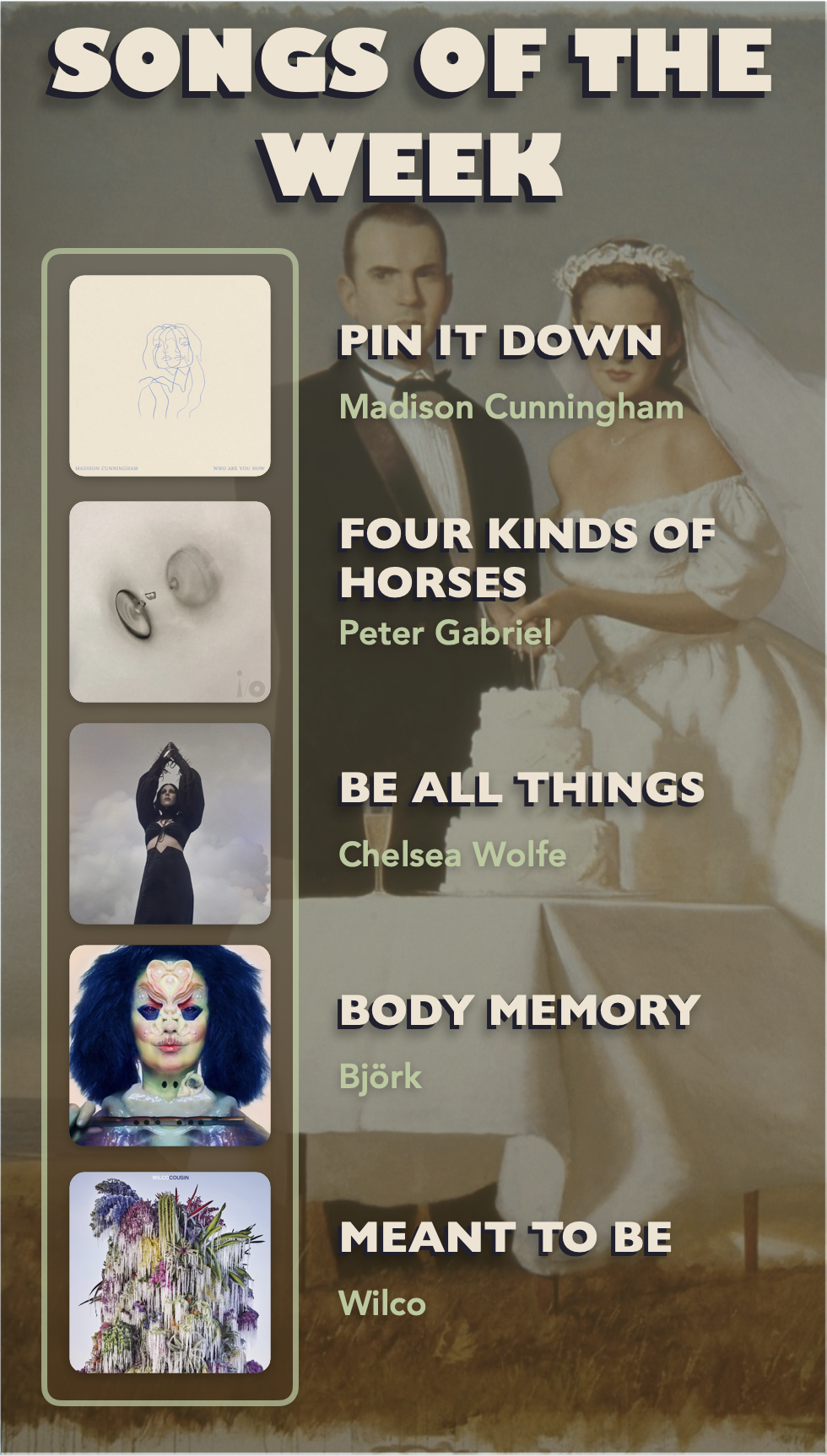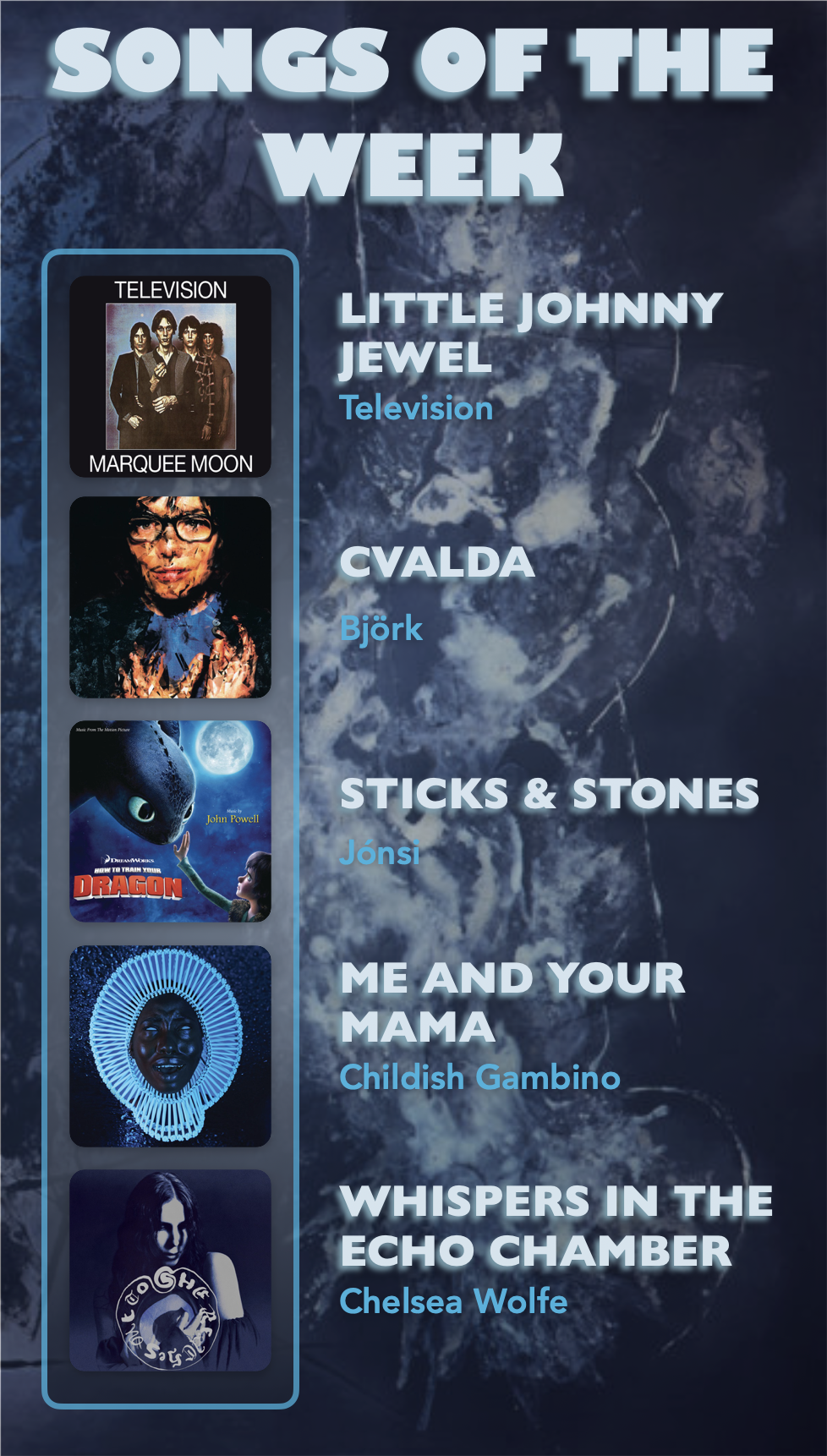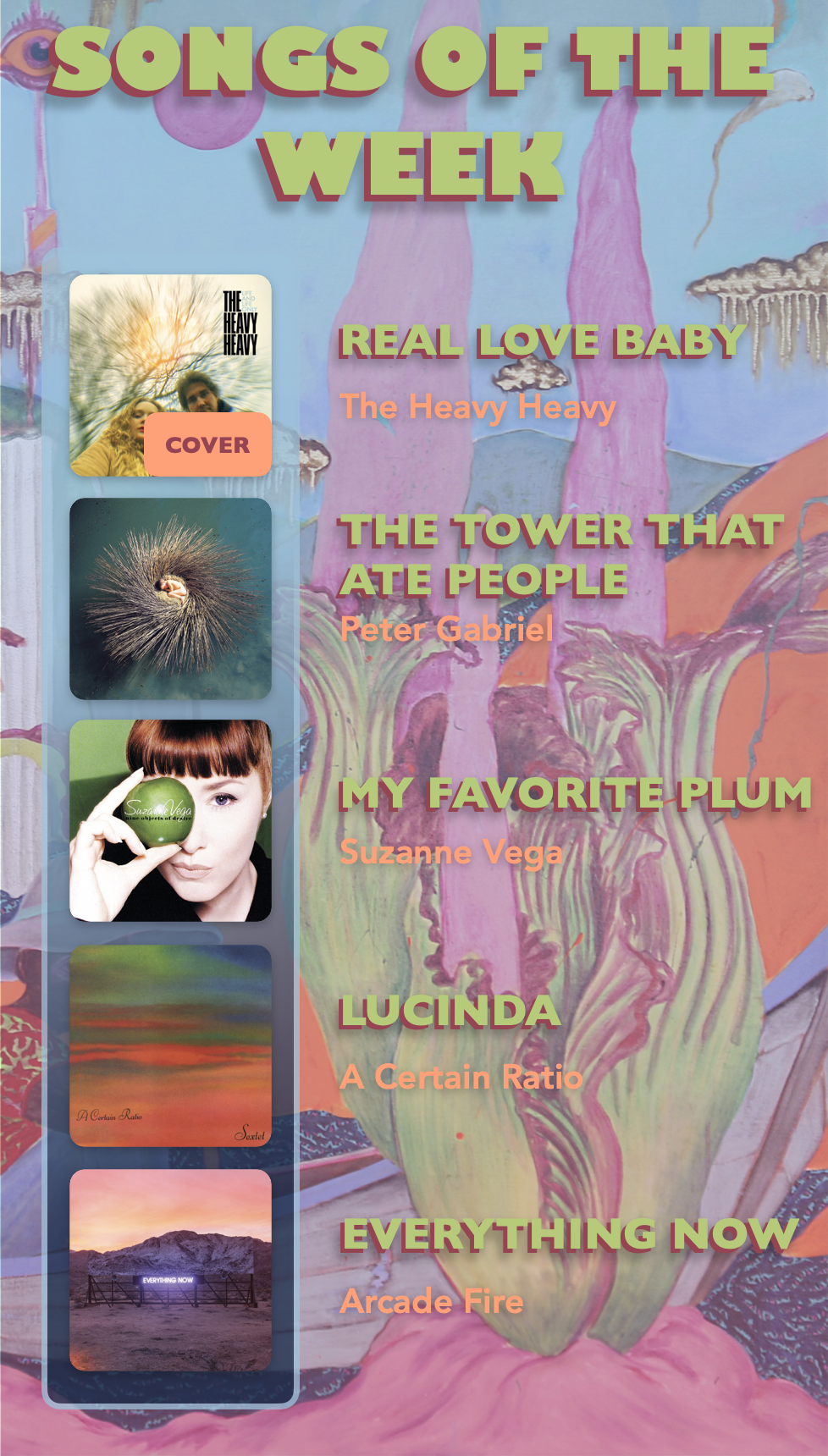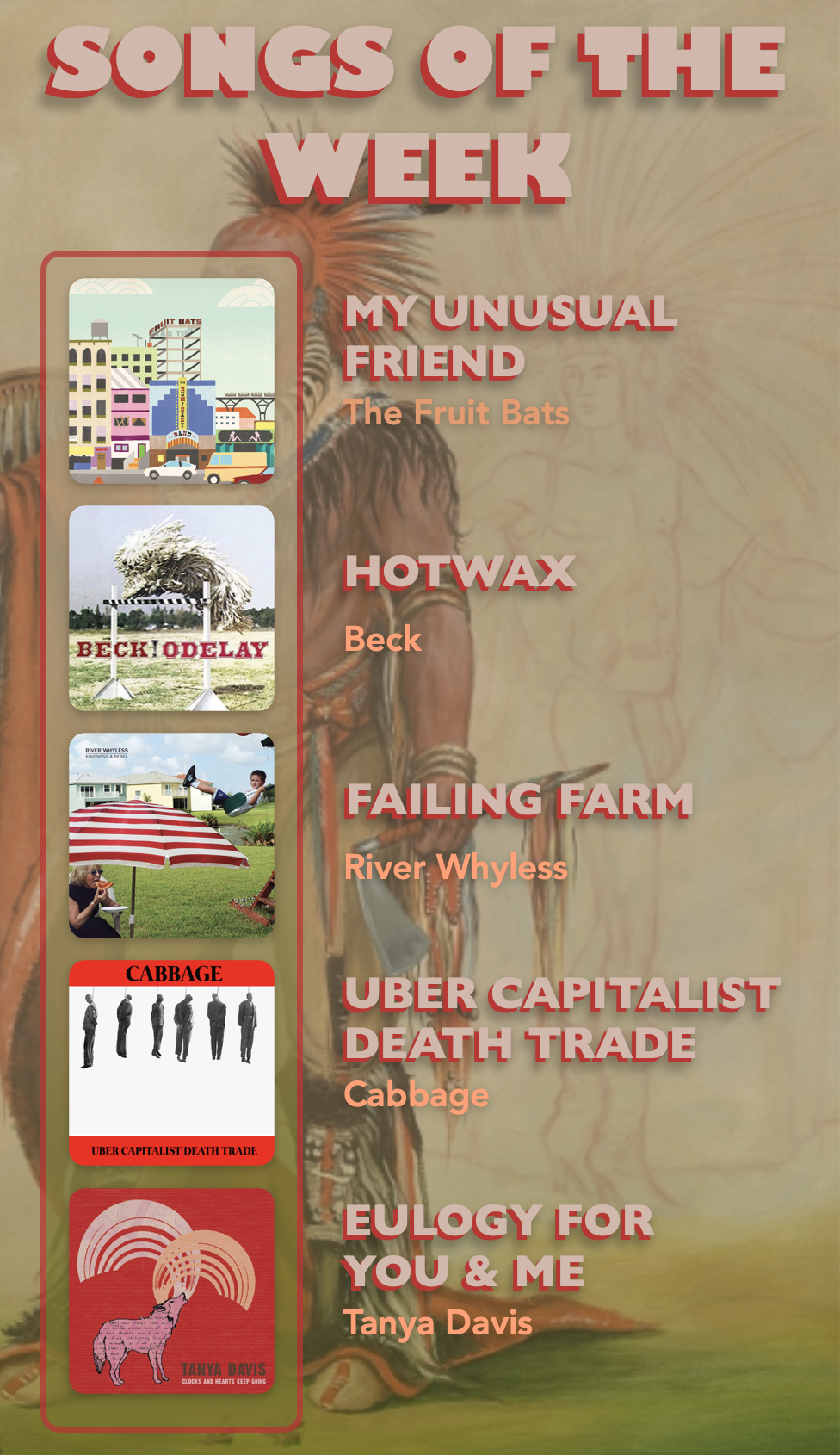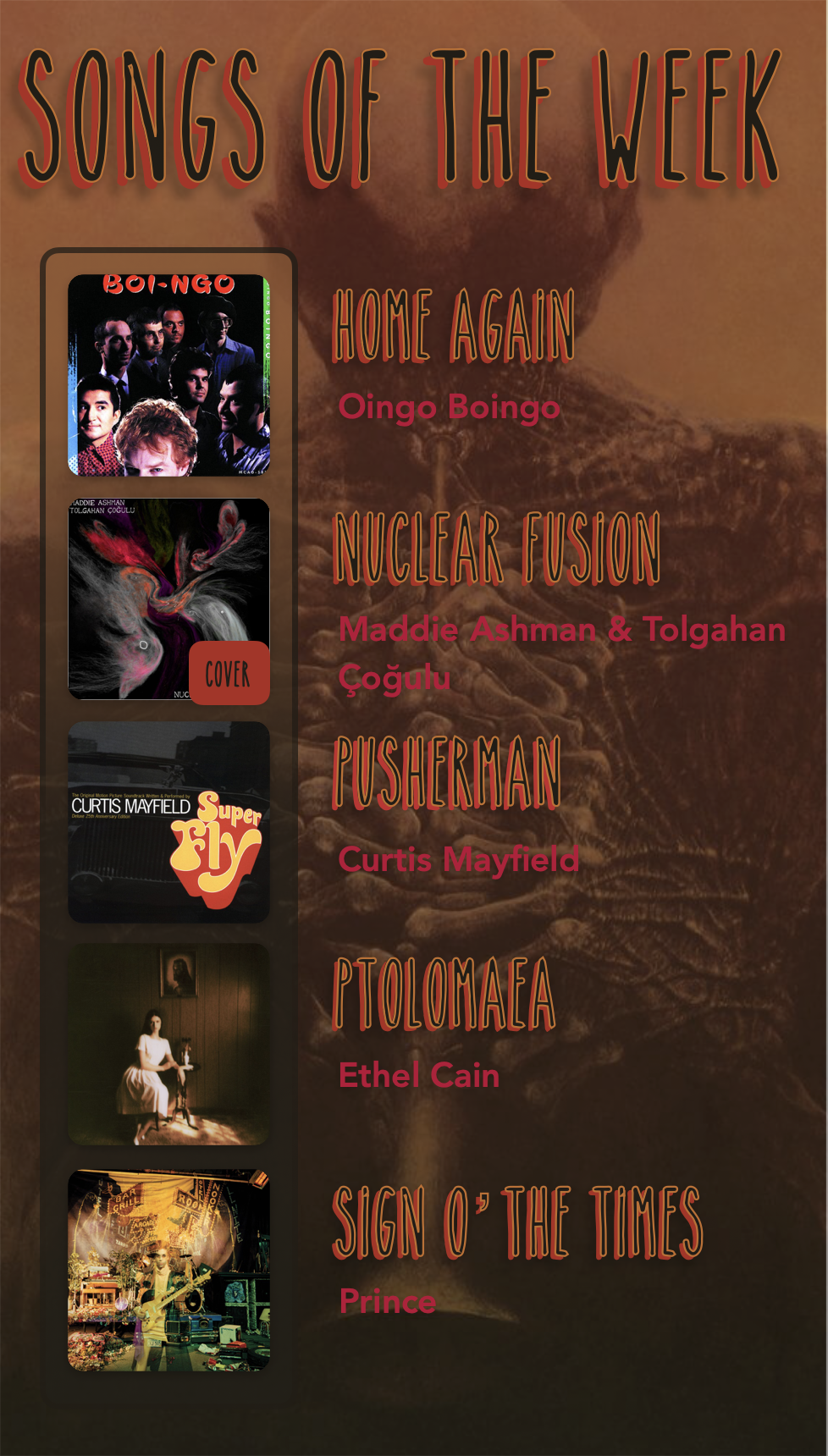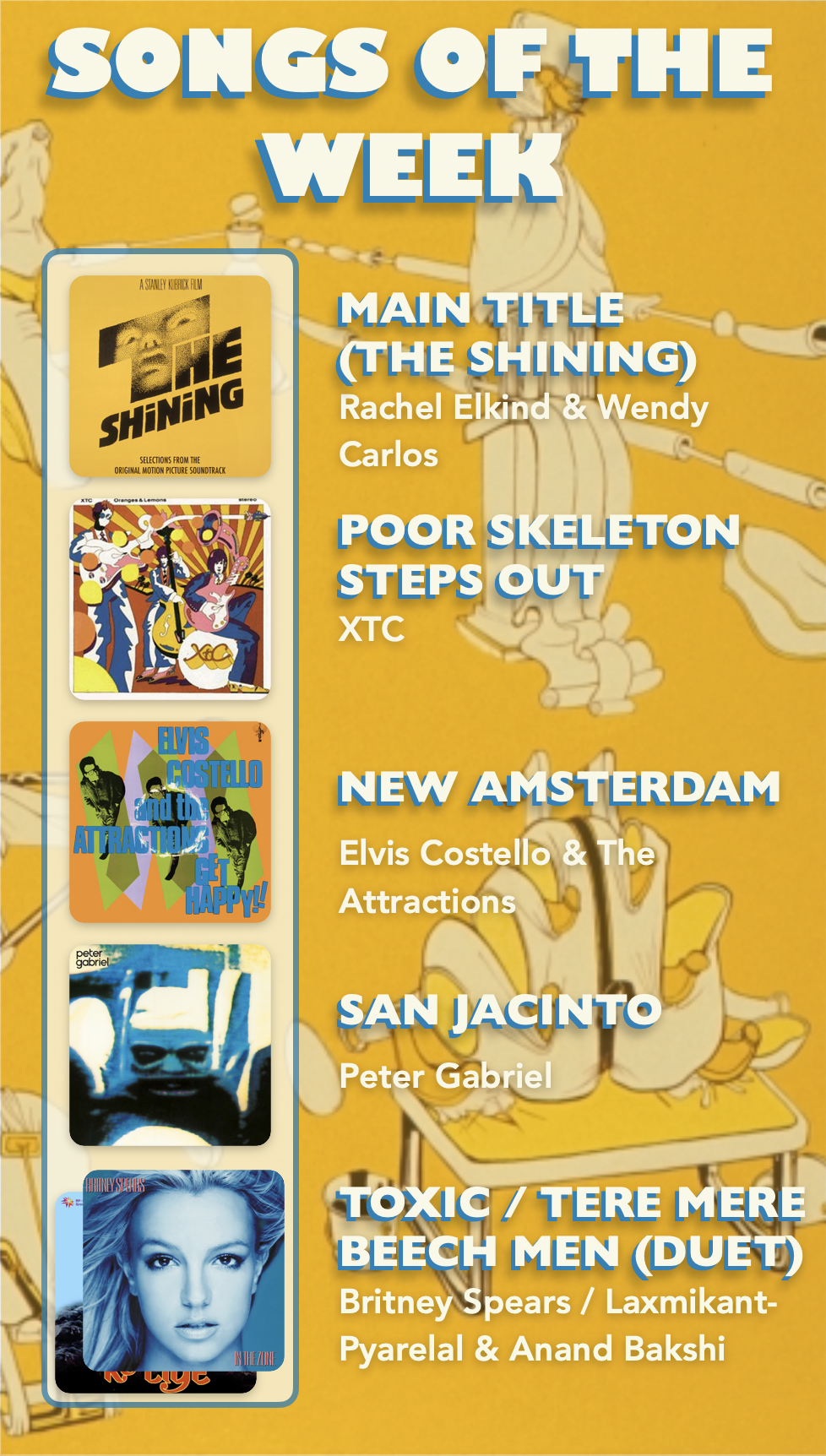Songs of the WEEK ANNUAL REVIEW 2023
Last January, I brought together every Songs of the Week from 2022 in a celebration of the year’s accomplishments… and dropped it four days late. This year, I told myself, I’d do better. I spent weeks training myself on punctuality—I punished tardiness with an iron fist, stepping on hot coals with my bare feet for every hangout I arrived to late, and rusty nails for every meeting. This December, I set aside three weeks to hole away and grind an annual review out—a real, proper sendoff to 2023. I didn’t see light for days, couldn’t feel the first Christmas snowflakes land on my tongue, but it was all worth it—all worth bringing you this year’s annual review on January 10th, 2024. You’re welcome, Idaho.
Songs of the year
…and that means songs I listened to the most, not the best songs I’ve heard for this entire year, okay? Sure, it’s a bit of a quality indicator, but there are some short and sweet gems that can’t be listened to without a repeat. Just had to get that out of the way, since apparently the plainest sixties pop song ever wasn’t worth the top spot on last year’s list. I will not stand for fapdorkly farky. Sorry, Fapardokly flack. None of those words sound real. This year, though, I’d say my top songs are a better indicator of my taste, which is always fun to see.
Before we get into that, though, I’ve regrettably got to hand it to Apple Wrapped this year for a development I wasn’t initially fond of: that users can track their top songs weekly. There’s an argument to be made that this ruins the New Year’s surprise for anyone without impulse control (and if you’re wondering where I fall on that spectrum, my gingerbread intake last week alone should tell you everything you need to know). At the same time, watching which songs raced to the top actually helped address one of my main criticism last year: that songs discovered earlier in the year have a head start. That might sound like filing a complaint against, like, gravity—you can listen to a song more if you find it earlier and that’s just the way time works—yet I’m not sure it’s a great representative of what music defined my year if the top songs are all from February, which is basically just last year’s backwash. To be fair, I’m not sure exactly what metric is a more accurate measurement—maybe the number of listens could be equalized by factoring in the rate at which a song is replayed, or the time between replays? I’m an armchair statistician at best, and anyways, Tim’s not paying me, so one of you Apple eggheads get crackin’ on that. All I’m trying to say is that, once again, quantity isn’t a quality indicator, though it’s surely worth something if I’m still yapping about it.
That’s enough complaining for the whole year, though—let’s talk trends! But not… not in, like, a LinkedIn way…
Where most of my top songs last year were pre-summer, three of my top five songs are from July, with two from the same review on 07/14/2023—it must have been a good week. While the other two songs did get the beginning of the year head start, it’s cool to see songs from the second half of the year represented here.
Three of my top songs this year also have over a million views on Youtube, so let’s face it, folks: I’ve gone mainstream, I’ve sold out, I’m an artless hack, I’ve lost all passion for music writing and only see it for the money fountain that it is, I must embark on a quest to rediscover the zest of art and artistry, etc.
All five of my top songs are by men, which is a shame, since the next four top songs—Apparat’s “Goodbye (with Soap&Skin)” [Reviewed 04/14/2023], St. Vincent’s “Bicycle” [Reviewed 03/24/2023], Soap&Skin’s cover of “Me and the Devil” [Reviewed 03/31/2023], and Björk’s “Atopos (feat. Kasimyn)” [Reviewed 2/17/2023]—are either written or performed by women. On a scale this small, I’m not sure it’s a metric that really matters, but I can’t help but feel a little neoliberal guilt.
At the risk of actually manifesting those artless hack allegations, I’ve reposted the reviews for each of these picks, but if you’ve been a Max Todd Dot Com (Max! Todd! Dot! Com!) follower since the beginning (like, thankfully, many of you have), feel free to skip to the next section—I’m not your dad. That’s enough waffling, though—let’s check out 2023’s top songs.
EVERGREEN | Shakey Graves [Reviewed 07/28/2023] From o7/28/2023:
“And we're still not even through with the new releases! While I fully disagree with "Vampire Empire"'s reception, I'm very sympathetic to the worry after hearing a new song live that the recording won't live up to it. Thankfully, after seeing Shakey Graves retool new single "Evergreen" several times live, I'm so happy to say that dude is still going strong, because the official version is maybe the best iteration of the bunch. While I can't say I was the most enthused by the lockdown-era acoustic version debuted in a youtube interview, seeing Shakey play "Evergreen" with a full band at the Dillon Marina back-to-back with "Look Alive" (a pairing that only barely didn't make the cut), I was 110% onboard. I've seen him once since then, where more pieces of the puzzle fell into place—were those Blade Runner and Close Encounters tunes playing before the show? This, of course, was the night before his new album, Movie of the Week, was announced, with "Evergreen" finally dropping as the second single. So, it's been a long journey, but enough history—what makes this song so good?
Having dropped the same day as Vampire Empire, it's no wonder these two songs have so much in common—in this case, both artists really swung from their folkier sensibilities to a crunchier side without losing the former, and it works incredibly well in their respective favors. Despite the trepidation of record companies with his last album Can't Wake Up, Shakey Graves has made the leap from folk to near-psychedelia with flying colors, taking another, natural step from the synth-heavy Look Alive EP and songs like "My El Dorado" on his latest rarities collection Deadstock into accentuating the weirdness he's always had. "Evergreen" not only shrieks here and there, but somehow simultaneously maintains the smoothness that has always been inherent in its easy tempo and sweet lyrics, capturing an almost trippy atmosphere that I am all about. Not only that, but it's incredibly catchy, taking a page from indie rock stylings of Can't Wake Up—tied with Roll the Bones as my favorite Shakey Graves work to date, and one of my favorite albums ever. Top twenty, for sure. Or maybe thirty? That doesn't sound super high but like I said, I'm just very hesitant with favorites. Hopefully we'll be talking about Movie of the Week on favorites lists, too—I don't want to get my hopes up too high, but both "Evergreen" and prior single "Ready Or Not (feat. Sierra Ferrell)" have been not only instant earworms, but for me, instant classics. And what range, too, right? Anyways, I'm rambling. Keep your ears peeled for this one, though. Whatever that means.
Pairs Well With: "My El Dorado" (Shakey Graves) [Reviewed 03/10/2023], "Special Cases" (Massive Attack), "Swim to Sweden" (Co-Pilot)”
THE CLOCK | Thom Yorke [Reviewed 02/03/2023] From 02/03/2023:
“I'm not sure how exactly this works, but while I can wait to listen to something like Vespertine for months or years on end, sometimes I'll listen to an album I've only just discovered back-to-back on a whim. Such is the case for Radiohead and The Smile vocalist Thom Yorke's first solo outing, The Eraser. I don't often look through my apple music "for you" page because I resent suggestions from robots, but when I did so last weekend in search of nothing in particular, I was immediately drawn to The Eraser's eerie, cartoon cover, drawn in that scratchy, Radiohead style that I think I've been unconsciously emulating in my Dream Story illustrations. Like the empty, monochrome inks of this cover, it's clear there's something missing in The Eraser's white space, though I don't mean that as any disrespect towards Yorke—even considering his Radiohead tenure, striking out solo for the first time must have been an entirely different experience, and a lesson on fleshing out one's own imagination. Recorded back-to-back with Radiohead's sixth album Hail to the Thief, The Eraser sounds much like a late Radiohead song dissolved down to its skeleton in a vat of acid—a skeleton that, while notably sparser, still features some thrillingly eerie beats and sounds. Though I'm uncertain if "The Clock" is still my favorite track on the album, it has perhaps the clearest dicernable lineage when it comes to mapping Yorke and Radiohead's evolution. Specifically, I've found a number of notable ties between The Eraser and Radiohead's seventh album, The King of Limbs: "Skip Divided" sounds like a blueprint for "Feral," and "The Clock," today's pick, even has several transitional stages. I'm not sure how many of my crackpot postulations comparing music to phylogeny hold up to scrutiny, but there's an undeniable family line between "The Clock," Thom Yorke's Twilight: New Moon (that Twilight: New Moon) single "Hearing Damage," and The King of Limbs's "Morning Mr. Magpie," which I have already expressed my undying adoration for.
To be clear, "The Clock" stands wonderfully on its own despite not reaching quite the heights of its progeny. With its palpitating baseline, radio-static guitar, and hissing vocal percussion that turns Vespertine's whispers spine-tingling, this track is full of sounds you'd be hard-pressed to find combined anywhere else, proving that Thom Yorke's experimental voice still persists when his collaborators are stripped away.
Pairs Well With: "Hearing Damage" (Thom Yorke), "Morning Mr. Magpie" (Radiohead), "Sue (or In a Season of Crime)" (David Bowie)”
WHEN I WAS DONE DYING | Dan Deacon [Reviewed 03/31/2023] From 03/31/2023:
“One of my favorite recent memories of coming home from college was opening the door to find my mom drawing a harebrained conspiracy map connecting every character in Netflix's time-traveling murder mystery, Dark. Pitifully, I'm only four episodes into Dark as of writing this, but I've willingly spoiled many of its needle-drops. Whoever was in charge of its soundtrack absolutely killed it (and it's weird that that's a way of saying good job, isn't it?). It follows, then, that I should probably be patient and only write about Dan Deacon's triumphant and transcendental "When I Was Done Dying" once I've actually seen it in the show, but in the spirit of, um, time travel, I'm going to pretend I don't understand the term "delayed gratification." If it wasn't apparent from the title, "When I Was Done Dying" is a psychedelic tour-de-force, evoking extra-dimensionality from the start with its nervous strumming layered over sweeping, doppler horns. This undulating rhythm at once creates both cosmic scale in the white space and texture in the scratchy, earthy imperfections of its instrumentation. Its rambled lyrics are equally epiphanic, spewing forth poetry line after line. This atmosphere is so overwhelming that I only caught snippets of the lyrics for the first few listens, but there are many gems to be unearthed between each fleeting breath. It was only yesterday that I was finally floored by perhaps the best stanza of the song:
"And the Earth looked at me and said 'wasn't that fun?' / And I replied 'I'm sorry if I hurt anyone' / And without even thinking cast me into space / But before she did that she wiped off my own face / She said better luck next time don't worry so much / Without ears I couldn't hear I could just feel the touch / As I fell asleep softly at the edge of a cave / But I should have gone deeper, but I'm not so brave"
I'm ashamed to admit that for many years, I felt that the influence of psychedelics on writing as emotional as this cheapened the final product. I've realized now that I'm critical of not the writing itself, but the way in which it's received—the way so many respond to abstract or dreamlike art by dismissing it as little more than a weird trip. To me, this is just demeaning, and a reductive perspective on the human imagination. I don't mean to sound entitled here, but when I try to make surreal or imagistic art, I put so much thought and effort into tapping into my imagination—into finding archetypal meaning in the images I'm invoking—and to experience that and only say "lol, don't do drugs kids" feels like a refusal to dive into the creative thinking every one of us is born with. In any case, songs like "When I Was Done Dying" and the deeply emotional journey it describes certainly aren't cheating because they came from a trip—in Deacon's case, I like to believe this piece and its discoveries has always existed within him, and the transcendental experience is just what brought him to it. No matter how it came about, this religious rebirth moves something deep within me, too, and that's what's worth it.
While there are some songs self-contained songs that I think would be ruined paired with visuals, such an imagistic piece is ripe for animation. Before I'd known anything else about it, "When I Was Done Dying" was already conjuring a scene in my head. To me, it's a perfect fit for claymation—there's just something in the stuttering strings and raining marimba that sounds like descending through the layers of strata beneath the soil, passing flint and fossils, bugs and bedrock. Mostly, I think it would be fun if cartoony Earthworms curled in to sing the high parts. As it turns out, Adult Swim beat me to the punch eight years ago with their nine-animator music video. Even though my idea is unquestionably better, I have to admit, this one is bursting at the seams with neon creativity that couldn't fit the song any better. It's such an imaginative firework of art that it can be overstimulating to experience, and I almost feel like I missed something in all the ruckus, but if that ain't what "When I Was Done Dying" is about...
Pairs Well With: "Of Course" (Jane's Addiction), "Judy Garland" (Frog) "You'll Be Bright (Invocation Part 1)" (Cloud Cult)”
GOTTA GET UP | Harry Nilsson [Reviewed 07/14/2023] From 07/14/2023:
“Nilsson schmilsson, amiright? Shit, wait—did he already use that?! Okay, while I have my interns formulate another snappy dismissal, let me come clean about my Harry Nilsson hangup: I saw his acid-inspired kids' movie The Point, and everything was downhill from there. For full transparency, my unironic adoration for The Point is undoubtedly skewed—I watched it with my girlfriend on a whim the same night I told her I liked her almost three years ago now, and those memories will forever be set to this soundtrack. Yes, it may be a Yellow Submarine ripoff, and yes, its profundity may or may not be dependent on intoxication, but this movie has so much hippie heart and art that I can't deny it. Just check out the scene my girlfriend showed to sell me on it:
But after ascending The Point's peak, a fall was inevitable, and for me, Nilsson's was swift and decisive, like a stab in the back: bro wrote "Coconut." Asterisk, footnote: Okay, before all 35,000 people who liked this song on Youtube come for my neck, it's a pretty cool song, but I have a vague memory of visceral annoyance hearing somebody singing "she put the lime in the coconut" in a stupid voice when I was a kid and it has never left me, so take that. In all seriousness, as much as "Coconut" reflects some of Nilsson's best, it also has plenty of what I'd consider his worst, goofiest cheese. Okay, why is that not kosher but Thomas Dolby is? Man, I don't know, but I have a feeling it has to do with sincerity. I know this might be a little slanderous given what a classic album Nilsson Schmilsson is—you know, Reservoir Dogs and all that—but after skimming through the whole thing in the midst of a pretty bad Covid slump (I wanted more The Point and I wondered if Wilco's wonderful Schmilco was inspired by this title), not one song hooked me in the first fifteen seconds or so, which is pretty much all you need to hear before you decide if you like a song forever, wham, bam, thank you ma'am.
So, anyways, clearly that's not true, because here we are, talking about the opening track of Schmilsson (and also of Russian Doll, I guess). Let it be known: whether or not I like Harry Nilsson's persona (dude is just Schoolhouse Rock for stoners), "Gotta Get Up" unequivocally rocks. A drunken, tilted, twist on a cheerful morning montage, this song expertly rides the line between gratingly cheerful and hypnotically neurotic. Between the upbeat, almost Broadway piano in the opening and the descending, angry horns at the end of every stanza, it's a wonder this song doesn't give in to the chaos it should theoretically create, never erupting beyond an anxious whimsy. Songs like "Gotta Get Up" make me reconsider the preconceived associations I have with certain keys, progressions, and styles—many of us, myself very much included, feel the associations in sounds so deeply that we often forget that they were culturally reinforced. It's a nature vs. nurture puzzle I'm not sure I'm equipped to argue either way, although I have a hard time believing that culture arbitrarily assigns emotions to sounds as if there isn't already some biological (or, dare I say it, spiritual) resonance with said sounds. Either way, music that confuses these associations seamlessly within the confines of a pop song has my immediate admiration, and just as it asks listeners to reconsider certain sounds, "Gotta Get Up" once again has me reconsidering my harsh Harry Nilsson takes.
Pairs Well With: "Poli High" (Harry Nilsson), "Mean Mr. Mustard" (The Beatles), "Log" (Tall Dwarfs) [Bonus: try this one next to Björk's "Army of Me," because it's also a pop song with very unorthodox composition, and everything logically should say it's a terrible fit, but it popped into my head, and it's... not bad?]”
LOVE ROLLERCOASTER | Ohio Players [Reviewed 07/14/2023] From 07/14/2023:
“God, I love funk. You guys like funk, right? God, I love funk. I'm such a funk poser, though, because when I say "I love funk," what I really mean is "I love the five or so funk songs I've heard, which, based on my statistical analyses, is an accurate representation of the genre's entire span." It's not, and I know that it's not, but because I'm lazy or stupid or just unfunky, I just cannot catch the funk train. My booty remains in a stifling prison of corporate, khaki unfunk, yet it yearns to be freed. Even despite being cursed to roam the earth without a glittering cape and peacock-feathered fedora, though, I've been loving the hell out of Ohio Players' classic song "Love Rollercoaster" since at least mid-May, and there's almost too much for me to sing my praises for in a single post. Some things I love about "Love Rollercoaster" lore, in no particular order:
1. For Damn Near Twenty-Two Years, I Was Listening to the Wrong (and Dubiously Official) Version of "Love Rollercoaster": So, picture yourself as my Dad, in 2010: your beard is short, as is your son, and so is your Ohio Players collection on iTunes. So far as I can tell, Ohio Players only dropped their album Honey on streaming recently, meaning my Dad had to find his funk fix elsewhere. Thanks to mysterious benefactors Driving Hits of the 70s! Vol. 1-8, for a time, we had our discount Ohio Players. The flat, blue background and the car-clipart cover should've been my tipoff that maybe this was more like the Infatuation Bumper Car, though, because this version sounds stiff enough to have been cobbled together with mere midi instruments and a dream. I'm still quite nostalgic for this version, even though I'm very happy to have found the superior original recording, but looking back, I can't find the Driving Hits of the 70s! take anywhere on Apple Music these days—Volumes 1, 3, and 8 all have Luther Ingram's "(If Loving You Is Wrong) Then I Don't Want To Be Right," Ambrosia's "Holdin' On To Yesterday," and Fortune's "Here Comes That Rainy Day Feeling Again" on them, though, so either they're running out of ideas or—and you can say I'm not feeling the Love Rollercoaster, but it's just a thought—they're replacing tracks that were once there but have since been copyright claimed. Just a thought.
2. This Goofy Fun-Time Funk Track Features a Murdered Woman's Scream as Backup Vocals—On Accident, I Guess: If you find this song anywhere with a comments section, you're bound to hear that apparently, cover model Ester Cordet was either a) murdered in an alleyway outside the studio while "Love Rollercoaster" was being recorded, or b) murdered literally inside the recording booth and they just...kept rolling? Most of these comments nostalgically recognize this as nothing more than an urban legend that was whispered between curious kids, but honestly, I choose to believe this is true. Like, imagine feeling the funk so hard that you can't stop the jam when a woman is audibly murdered. Imagine hearing her dying shriek hit exactly the right spot before the breakdown, and everyone looks at each other uncomfortably, and then at the soundboard, all silently signing some mutual pact to never speak of what you have seen, but to still keep it in your new album's single, because god damn, it does sound good, right? You can actually hear some version of the scream twice in the song, so far as I can tell—at 0:09 and, as is most often cited, at 2:32—which would mean Cordet hit that death note so hard that they had to use it twice (rest in peace, though). After doing some digging, it seems that this old rumor has gained so much notoriety that it can be found on the Wikipedia page for Honey, along with another rumor that the titular honey on the album cover ruined Cordet's skin and derailed her modeling career. I just think it's wild that hauntings like this crop up in the least creepy places—I find nothing but joy in this song, but to think others might have these superstitious associations with it is crazy to me.
3. Also, "Love Rollercoaster" Really Slaps: Even with those two fun facts aside, how am I supposed to contain my "Love Rollercoaster" rave to a single paragraph? Aside from how criminally catchy that opening riff is, there's so much here to shout out, from the smooth side commentary ("say what?" I don't know, man, but I'm sure glad you said something), to the startlingly low baritone backup vocals, to the the harmonizing horns. All of this and more culminates in an organ-and-horn freakout that magnificently dissolves away from the tight tempo. It was probably skull-shattering back in the day if you were hitting that hippie pipe, and even sober, hearing those outro "love rollercoaster" vocals just feels like something to behold. It's exactly the bombastic, unabashed fun that funk was made for, and it always puts some brightness into my days. Thanks, Ohio Players.
Pairs Well With: "Flashlight" (Parliament), "Fantastic Voyage" (Lakeside), "Jungle Boogie" (Kool & The Gang)”
ARtiSTS OF THE YEAR
…and you thought having seven top five artists was bad last year. Before we get into the excel debacle below, let me first explain my criteria for ranking artists this year, because—that’s right—I have beef with past Max’s methods. Last year, I ranked the artists most frequently featured on Songs of the Week by lumping bands and their constituent solo artists together, meaning that, say, songs by both Jeff Tweedy and Wilco would count towards a single category. I think this is a much fairer way to represent the sound folks are listening to, since it eliminates the opportunity for a single artist with multiple projects to monopolize several slots in a list (or, on the other end of things, have their listens diluted over separate names). Last year’s readers may have noticed, though, that this lead to problems when multiple band members had their own solo projects, or would pair off in several splinter bands—I’m beating around the bush here, but basically… this is once again a Bauhaus spaghetti monster problem. A situation like this sort of had the opposite effect, lumping the styles of Daniel Ash, Peter Murphy, and David J into one stockpile of song reviews that incorrectly homogenized several distinct voices.
Worry not—to address this issue that wasn’t really bothering anyone, I’ve slightly modified my ranking system this time around. Now, you’ll notice that individual names are listed before any projects they are involved with (e.g. “Adrianne Lenker / Adrianne Lenker & Buck Meek / Big Thief”). You’ll also notice that individuals don’t repeat themselves, but projects do (e.g. “Buck Meek / Adrianne Lenker & Buck Meek / Big Thief”). The point of this is to highlight individual artists by giving them points for songs they’ve written solo and songs they’ve collaborated with others to create, honing in on whose art I’m resonating the most with without confusing the visions of multiple people (or giving them an unfair advantage). Okay, scandal resolved, I’ll do world peace next. While I work on that, here are my … twenty-seven… top five artists.
Last year, I featured two graphs in this section: one for my top five artists (involving a few ties, but nothing egregious), and one for every artist that appeared more than once on Songs of the Week that year. This year, you might notice that these graphs have undergone some sort of vile reverse-birth endosymbiotic assimilation, because—that’s right—there are so many ties in my “top five artists” that they encompass every repeated artist on Songs of the Week this year. So, to recap…
In first place, we have a three-way tie between Björk, Jeff Tweedy / Wilco / Loose Fur, and Shakey Graves—no surprises there, considering we had new albums from all three of these artists in 2023, all of which we’ll dissect in the next section. These artists were featured seven times on Songs of the Week.
In second place, it’s a four-way tie between Adrianne Lenker / Adrianne Lenker & Buck Meek / Big Thief, Alan Roberts / Jim Noir / Co-Pilot, Kate Bush, and Peter Gabriel / Genesis, all of whom were featured six times on Songs of the Week.
Third place is another four-way tie between Feist, Harry Nilsson, Hozier, and Trent Reznor / Nine Inch Nails, and before you nine inch nail me to the cross for Hozier surpassing one of my favorite-ever bands, I’ll remind you of who I’m dating. Not—not Hozier. These four were each featured four times.
In fourth place, we have another three-way tie between Chelsea Wolfe, Danny Elfman / Oingo Boingo, and Thom Yorke / Radiohead / The Smile, all of whom were featured three times.
Finally, in fifth place, we have a twenty-three way tie between… everyone else. Go look at the graph, I’m not about to write all of that down again.
I’m definitely overhyping the insanity of this all—it’s kind of funny at best—but the humor, for me, comes from the fact that twenty-three artists I reviewed only twice somehow made it into my top five under this criteria. Of one hundred and thirty-six artists reviewed in 2023, there were only twenty-seven who were reviewed more than once—only 20%. Last year, when 29% of artists were given a second chance, one of my New Year’s resolutions was to try more songs from new artists, and… well, the numbers speak for themselves on how that worked out. Still, I think this graphic might just be misleading. My top artist last year (Kate Bush, obviously) was featured a whopping fourteen times in 2022—double that of this year’s top contestants—which means reviews might be distributed more evenly this time around. In a roundabout way, I guess I was giving more artists a chance—just not quite the way I intended.
If you’re curious about a less… titillating… ranking system, Apple has given me a more definitive top five artists, based on listens alone (derivative). By that metric, my top five artists are Shakey Graves, Kate Bush, Wilco, Björk, and Peter Gabriel, which is… okay, it’s a spot-on assessment of my current music taste. Any excuse to give Kate Bush back her rightful queendom—I may have finished her discography by March, but there wasn’t a moment this year where I stopped listening.
ALBUMS OF THE YEAR
While number of listens may tentatively… admittedly… begrudgingly… be a better metric for gauging my top artists, I still don’t love that Apple Music also ranks albums by the cumulative play count of each song on them. It’s a bit of an oversight that, for once, doesn’t feel like a nitpick on my part. Simply put, if an album has more songs, it automatically ranks higher regardless of full play-throughs. This means that, as incredible as Daniel Pemberton’s Across the Spider-Verse score might be, at thirty-four songs long, I’d have to listen to Co-Pilot’s nine-song Rotate nearly four times through to equal a single play of Spider-Verse, and that just doesn’t make sense. So, while I know I replayed to both albums ad nauseam this year, it’s hard to say which truly takes the top spot using Apple’s count alone.
As with last year, though, the Albums of the Year (Al! bums! Of! The! Year! One! Syl! lab! le!) segment has never been a strict ranking, but instead a celebration of the best musical masterpieces I’ve discovered this year. Despite not finding multiple all-time favorites like in 2022, 2023 appears to have been a good year for music, since this time around, my top albums are all new releases. They say Rome’s best art came from the time when it fell, but I’m sure this holds no water as a portent of the west’s inevitable fall, no-no! Don’t think about it, America!
SPIDER-MAN: ACROSS THE SPIDER-VERSE (ORIGINAL SCORE) | Daniel Pemberton It’s not always about reviewing albums, Spider-Man… for me, it’s mostly about finding any and every excuse to talk about how goated Spider-Man: Across the Spider-Verse is. Far and away my favorite movie of 2023—I had to watch it four times in theaters, just to make sure—I still strain to find any aspect of this movie that isn’t perfect (their animators must have been thriving, right?). Of course, back in 2018, I was similarly starstruck by Into the Spider-Verse, and even while seated in the theater for Across the Spider-Verse, I was certain that the first film couldn’t be surpassed. That all changed with the very first chords of “Across the Spider-Verse (Intro)” [Reviewed 06/09/2023]—the beginning of this movie’s miraculous improvements on a nigh-untouchable original.
To be clear, Daniel Pemberton’s work on Into the Spider-Verse already had me blown away back in the day. The hair-raising “The Prowler” had the whole internet in a chokehold, but I was in love with all of it—the way every character’s musical cue was distinct, the way said leitmotifs were juggled as effortlessly as the script juggled its characters, the way both Peter and Miles’ themes sound like the word “Spider-Man,” the way songs like “Catch the S Train” are just as goofy as the movie without losing any of their cool factor… hell, with such masterful creativity, even the quieter moments like “Visions Brooklyn 1, 2, 3” have grown on me. Having bought the whole album, though, I can certainly say that those quieter moments kill the soundtrack’s momentum without a movie to support it, making many songs sound redundant out of context. Essentially, you can tell when Pemberton’s mindset shifts from going creatively nuts to just filling space. It’s something I figured all composers must contend with, so I cut these lulls some slack, not knowing how much better the next soundtrack would be. It goes without saying, but the soundtrack for Across the Spider-Verse is as absolutely bonkers as the movie that spawned it. The instrumentation is hyper-detailed, the leitmotifs are focused and distinct tidbits of a diverse cast, and like everything about Spider-Verse, it’s a miracle that this creative cornucopia can taste so good in a single bite.
In the shadow of successful predecessors, I imagine it’s an uphill battle for sequels to introduce new iconicity—even for superorganisms like Star Wars, it’s taken years for any prequel or sequel songs to rival the widespread recognition of a track like “The Imperial March.” The only reason songs like “Duel of the Fates” have earned the same ubiquity is because John Williams took a risk—in his case, introducing choral elements to the (at that point) strictly orchestral soundscape of Star Wars. Certainly, Across the Spider-Verse faced this same struggle—the “Bagel Effect” memes immediately following release incorrectly use The Prowler’s iconic theme instead of the Spot’s (yea, they called me “fun sponge” in high school, how did you know?)—but quickly overcame any lack of recognition. Over the last year, it’s been incredible to see how fast new characters and their theme music were absorbed into pop culture lexicon. Whether it’s the unfathomably nasty beat in “Spider-Man 2099 (Miguel O’Hara)” accompanying the widespread memeing of canon events or “Spot Holes 1” & “2” finding their footing in videos like “I’m gonna crease your Jays, Spider-Man,” it’s not an exaggeration to say that an entire generation embraced this soundtrack, with some songs becoming overnight classics. Like the many other triumphs of these movies, it’s incredible to be a part of something people will remember for years to come.
It blows my mind that Pemberton took these leaps of faith not only with new characters, but with previously established ones as well—even those who he’d already taken a musical stab at. Perhaps my only, minute grievance with these movies is the artistic discrepancies between them—for such a visually meticulous franchise, my immersion during Into the Spider-Verse is always momentarily lost when I see that Gwen’s (high school) Peter is the same model as the College- or middle-aged Peters we see in other universes, and this same model is also used for Miguel O’Hara in the genius end credits scene. It was almost a relief to see Gwen’s Peter looking younger and scrawnier, just as much as it was to see 2099 built like a fucking tank out of nowhere, but an out-of-universe fix just adds a second immersion break in-universe. While it’s technically an inconsistency, however, I actually really admire this franchises’s willingness to improve upon concessions they’ve made in the past, whether they be due to uncertainty in the story or the budget. While these animation details were almost certainly a budgetary sacrifice, Pemberton’s brave decision to adjust several leitmotifs was almost certainly thanks to shifts in the story—and that is a true thanks, by the way, because Across is far better for it.
“Spider-Woman (Gwen Stacy)” [Reviewed 08/25/2023] is the crowning achievement of this decision—taking what was once simply an identifying sound and giving it renewed depth. Gwen’s original theme (first featured in Pemberton’s “Are You Ready To Swing”) was already exemplary of Into’s ability to give characters immediately recognizable leitmotifs, but outside of the movie’s purposes, it felt sort of bland—while a generic punk-rock riff is great for signaling the arrival of your generic side-shave Hailee Steinfeld character, in isolation, it doesn’t convey much behind the stereotype itself. While this was fine (if reductive) in a movie where Gwen had little to do, when she became the sequel’s co-lead, a riff like this quickly became inflexible. Much like the writers fleshed out Gwen to create a charismatic and complicated character, Pemberton’s “Spider-Woman (Gwen Stacy)” paints a sound that’s both beautiful and fist-pumping—a sound that encapsulates not only what it means to be a spider-person, but what it means to be Gwen Stacy herself. Much like Gwen’s lush, watercolor world—a mood ring rolling through sharp colors with soft edges—this song has both the ethereal elegance of a dancer and the electric impact of a drummer. My girlfriend said it best when talking about Gwen’s general portrayal—she’s got a kind of power that’s allowed to be feminine, moving gracefully without being lithe, looking muscular without embodying a male action hero. In the same way, the glittering guitar that announce’s Spider-Gwen’s arrival captures so many characteristics and emotions in a single sound—her freedom, her aggression, her isolation, her responsibility. All that in a riff that’s also an easter egg—that’s right, those are the notes of the original sixties Spider-Man theme bunched into a single guitar riff! You know, “Spider-Man, Spider-Man / does whatever a spider can?????????” There is so much thought in this movie!!!!!!!! RAAAAAH I LOVE SPIDER-MAN!!!!!!!!!!!! I truly did this theme dirty in my two-sentence review—it captures the weighty weightlessness of feeling like a superhero so well that I had to blink back giddy tears the second Gwen dove from her window. Much like how I wish I’d known mixed-race Miles in my formative years, I am so happy for the kids that get to grow up with Gwen Stacy’s Spider-Woman and her incredible theme.
It’s this sort of magical tinkering that also makes me wonder where Pemberton’s Beyond the Spider-Verse score will take themes from both Into and Across—what will Jess Drew’s motorbike cue (first heard in “Guggenheim Assemble”) sound like with flesh on its bones? Will Mayday’s appropriately dopey “Peter and Mayday Parker” theme see some growth as she matures? There’s so much potential for more, but I’m getting ahead of myself here, because old or new, Pemberton’s score doesn’t just improve—it also smooths.
If this review has made one thing clear, it’s that I love leitmotifs—they’re a great way for audiences to instantly identify a character, and maybe even inject some subliminal characterization in there along the way. It’s especially cool when group action scenes are scored with a medley of leitmotifs as the tides of the battle turn, but this can be tricky to pull off—too many leitmotifs, and you lose the underlying score of the scene. I’m no composer, but to me, leitmotifs should underscore the overt emotions of a scene, not dominate it. This means I’m normally not a huge fan of listening to leitmotif medleys outside of the context of a movie—without the scene itself, this sort of song can start to sound a little messy to me. That all said, Pemberton’s Across medleys rock across the board. The aforementioned “Guggenheim Assemble” mixes the leitmotifs of Renaissance-universe Vulture, Spider-Gwen, 2099, and Jess Drew, webbing them all together with the main Spider-Man leitmotif in an insanely tight climax that perfectly captures the museum battle’s frenetic chaos. That main Spider-Man leitmotif—once again, both Peter’s and Miles’s—seem endlessly flexible, appearing bubblegum-triumphant in “Indian Teamwork” but nauseously foreboding in “Falling Apart,” both of which tie in leitmotifs from their surroundings. Perhaps the best medley of the bunch, though—“Across the Spider-Verse (Start a Band)”—proves that a singular mood can be achieved while chaining more than a few separate motifs. This piece wields leitmotifs so deftly that I’d call it Pemberton’s masterpiece, expertly choreographing every character’s appearance to turn this notorious cliffhanger into an absolute hype train. Pattering in to a trap beat, Prowler’s leitmotif spirals into a jaw-dropping reveal. Then, Spot’s signature howls condemn Miles to a terrible fate. Still, just as Spider-Man always gets up, the song contorts into something hopeful: the blaring “Spi-der-Man” horns burgeon with Gwen’s aggressive, persevering drums—drums that, tied in with Hobie’s guitar, harken back to the film’s first monologue about starting a band. That, folks, is how you end a mother fucking movie—juicing the story for all its worth with a score that blows your doors off.
I know I’m prone to hyperbole, but for once, this lengthy review has only scratched the surface of Daniel Pemberton’s Across the Spider-Verse score—and that’s just the score! I could go on about The Spot’s borderline-horror theme being an evolution of Kingpin’s collider theme and how it impossibly follows The Prowler’s previously unbeatable villain song, or how “The Anomaly” expertly executes an unfathomably dreadful plot twist, or just how creepy the little noises in “The Go Home Machine” sound, and I still wouldn’t have done these thirty-four songs justice. For your sake and mine (I’m getting tired of writing), watch Spider-Man: Across the Spider-Verse—this work of art in all its facets will defibrillate your inner child.
ROTATE | C0-Pilot If I was to pick a defining album of the summer, though, I’d choose Co-Pilot’s debut Rotate in a heartbeat—and not just because I simp for Jim Noir on the regular. While it’s true that Noir—or Alan Roberts, behind his stage persona—has been a favorite musician of mine for some time, as the song “Move To It” [Reviewed 07/28/2023] declares, Co-Pilot “is the start of something”—something new, something different, and something I never saw coming.
In March of 2022, Roberts renewed his Patreon campaign, releasing a monthly EP with the promise of up to three albums as the eventual byproduct—a promise that has appeared to have fallen through, given that we are now twelve EPs into a ten-EP voyage, the last of which was dropped this July with no signs of an album in the interim. Much as that sounds salty, I’m glad the man is getting a break—the sound of burnout was beginning to creep closer every month, which is something I’d hate for such a prolific creative to suffer through. It seems, though, that Roberts was instead busy elsewhere, because a surprise dropped at the end of July: an album under the band name Co-Pilot, a collaboration between Roberts and frequent collaborator Leonore Wheatley of The Soundcarriers, The International Teachers of Pop, and of course, Jim Noir’s own band (you can spot her in the background of this bootleg live performance of “Kitty Cat” at the Manchester Garage in 2011! She’s like… seven pixels tall? I feel like such a creep). While I’d listen to anything that man put to MP3, it seems that collaboration was the cure he needed, co-piloting a wholly new sound that reeks of both his best attributes and Wheatley’s.
There isn’t a bad song on Rotate, but boy, this album is front-loaded, stacking four instant classics back-to-back. This square of songs boldly demarcates Co-Pilot’s style, but their potential is anything but boxed in. With a history of live performance already behind them, the two were already set for success, but it’s still astonishing to watch them hit so many home runs from the start. Roberts’ sixties whimsy comes to electronic fruition amidst the ethereal atmosphere that Wheatley brings from her (equally sixties) Soundcarriers days, mixing into this smooth, smoky elixir that I struggle to find the words to describe. Kitbashed phrases like “cosmic electronica” have been offered up by reviewers, but while there’s something alien in Rotate’s many hyperactive chirps, it’s certainly not as unfocused as space. Maybe I’m biased by association, but Rotate’s album cover to me comes closest to capturing its sound—the foggy buttons of a dusty, airplane dashboard blinking back to life, as though a warm, glowing ghost has just phased through the cabin.
For as much as I want to say that the opening track, “Swim to Sweden,” sounds like if hyperpop was actually a good genre (sorry, 100Gecs), I’d be ignoring that muted, antique quality—a glimmering that, as it turns out, Roberts sampled from a passing Ice Cream Truck (augmented incredibly by that oh-so-Jim-Noir-bass). It’s these retro tidbits—intentionally fermented—that lend such life to what might normally sound like synthy gibberish. While “Move To It” certainly takes the opener’s energy a step down, its sample is equally well utilized, turning the Mattel Optigan Music Maker’s much-salvaged sound 70013 (the backbone of C418’s “Chirp” and our man Daniel Pemberton’s “The Orb of Dreamers”) into a hazy, mysterious, and I’d even say curious song that comes to a goosebumps-inducing crescendo. “Move To It” held my top spot on the album for weeks, but it was soon dethroned by the song straight after—“Motosaka” [Reviewed 08/25/2023]—which pays tribute to a pioneering influence of Roberts’s, Ryuichi Sakamoto (spoilers for next year’s SOTW), by sampling his track “Thousand Knives.” I’d hate to knock the classics, but while “Motosaka” certainly loses the almost jazzy complexities of Sakamoto’s work, I actually like this buzzy pop song better. From its spiralling piano jam to Wheatley’s stunning, rainy harmonies, “Motosaka” is a sci-fi firework that I wish I’d taken more time to review back in August. It’s a high the album deserves to linger on, and yet Co-Pilot just keeps barreling forward with yet another banger, “Brick,” a title that—if Trent Reznor & Atticus Ross or Jeff Tweedy are anything to go by—means you’re in for a good time (though I’m omitting the obvious outlier here, Ben Folds). While not quite as strong as its predecessors, “Brick” is a hypnotizing, meticulous piece that makes me want to go into Master Builder Mode (let’s see what you’ve got, Chrisp Ratt), and it’s a fitting end to Rotate’s first half.
While it fits so well next to “Brick” that I can’t listen to the two separately, “Can You See” marks a turning point in the album—while it’s just as much of a pop song as the preceding tracks, it has much more spacious verses, signaling a more pensive second half. On the first listen, I took this to be a sign that things were winding down, and after four hits, Rotate’s quality would rightfully wane. After many full listens, though, that’s just simply not the case—if you’ve heard Wheatley’s other work, you’ll know that now is her time to shine.
While they never quite reach the first half’s speed, Rotate’s last four songs are all about build—a brave way to finish a pop album, but one which rewards patience with the best vocal performances yet. Whether it be the saccharine ballad of “I am 1” (featuring a reference to Jim Noir’s obscure-within-obscure “We Are the Numbers”), the watery, Morcheeba elegance of “She Walks in Beauty,” or Robert’s instrumental flexing in “Spring Beach,” these songs approach quite differently, albeit all at a meandering midtempo. They’re worth every listen, but I don’t think I’d appreciate their beginnings as much without their crescendo ends, which highlight Wheatley’s magical harmonies worthy of Carolina Eyck backing on Theremin (I can dream). According to Wheatley, these were at least in part Arcade Fire-inspired, which certainly explains their more symphonic feeling. While not explicitly mentioned by Wheatley, the album’s closer, “Cornerhouse,” pairs excellently with Arcade Fire’s “Rococo”—it’s a sweet, swaying ending that sounds less like a lullaby and more like a summer sunset. I’ve found this style of song pretty melancholy in the past, yet despite its sleepiness, “Cornerhouse’s” sweeping percussion and repetitive assurances imbue it with a hopeful happiness. Like the ending of a kid’s show, it promises more fun on the next episode, and given the hints of weirdness even here (what’s up with the way Wheatley’s delivery of “Cornerhouse” dips flat, and why is it so awesome?), I can’t wait to see what Co-Pilot cooks up next. Yes, Co-Pilot, that means I would adore if you created a film or TV score. I’ll call you when I get that contract, someday.
Of course, this ending does leave me with some questions—namely, what’s up with this album order? While I’m not necessarily opposed to the way these nine songs are arranged, I can’t help but see potential for different pacing here. Namely, this album’s second half has many songs that could actually work better as openers, building up to the energy that “Swim to Sweden” immediately spoils us with. For one, the crescendo of “I Am 1” would transition excellently into “Sweden” or “Move to It,” and I mean, that would be pretty clever, right? Or—even though I just waxed poetic about what a good ending it is—I can even see “Cornerhouse” opening the album, given its line “Start from the beginning.” Maybe I’m trying to be too clever, though—Rotate shoots for the stars and plateaus at that peak, staying fantastically creative even as it slows to a stop. While I have plenty of Leonore Wheatley to catch up on in the interim, I’m eagerly anticipating Co-Pilot’s next outing, whenever it may come—this collaboration brought the best out of both creators, and I can’t wait to watch them work their magic again.
COUSIN | Wilco You know the old saying about how the biggest Star Wars haters are Star Wars fans? The amount of Star Wars tantrums I’ve witnessed is probably inexcusable, but I can sort of empathize with where they’re coming from. Being so deeply archetypal, Star Wars probably hit a spot with its initial viewers that was too personal to surpass in later iterations—so much so that for many, sequels actively sully that initial spark. Compound that with Star Wars eras defining childhoods, and things get even more personal—more on a pedestal.
Unrelated, but I’ve been a huge Wilco fan for my whole life. As a tiny toddler, I asked to hear “Can’t Stand It” over and over, closely followed by “What Light” and “I Am Trying to Break Your Heart”—all tracks my Dad practically raised me on. I’ve seen Wilco some eight times since I was in second grade, and listened to every full album on release day since The Whole Love. Not only have they been a huge part of my musical maturation, but also understanding myself—where would I be now without hearing “Theologians” from such a young age? So, when their long-teased art-pop album dropped its first single, “Evicted” [Reviewed 08/25/2023], here’s what I had to say:
To be fair, I'd call a pretty broad selection of Wilco's discography art (or experimental)-music, but within that lies a spectrum—some albums, like Yankee Hotel Foxtrot, are emotional tour-de-forces with inventive and scatterbrained soundscapes; others, like Star Wars, aren't quite as emotionally flooring, but make up for it with their gleefully bizarre artistic choices. When it came to this ghost art-pop album, I was expecting something in-between—I'd always be disappointed if I thought every upcoming album would be Yankee Hotel Foxtrot 2, but after the corruption of an ongoing pandemic, I figured there might be more emotional range than the upbeat fun of Star Wars. In other words, I think I was expecting something akin to The Whole Love—as close to an art-pop album as I think Wilco has yet come, with both fun bubblegum and more contemplative experimentation. I guess I should be thankful that Wilco is still surprising me, though, because the first single from said art-pop album—Cousin—has released, and it's... none of these things at all.
[…]
There's no directional or aesthetic shift to "Evicted," even on repeat listens—to me, this could have come from any of their past three albums, especially Ode to Joy and Schmilco.
This is embarrassing.
I knew then as I know now: with musicians as mature and subtle as Wilco, patience is the key. For any of their albums, I’d call a second listen mandatory—there’s so much to get excited about in their instrumentation, their composition, and their lyrics, but it’s all subdued enough to sound sleepy. Still, after weathering a pandemic knowing it had delayed something as exciting as an art-pop album, I felt a little bit cheated by a single that, as I wrote then, sounded like an average of Wilco’s past four albums. As is so often the case, I could talk the talk, but when I first listened to Cousin, I couldn’t walk the walk. That’s just how these things go—I listened, marinated, and listened again, then again, then again, and wouldn’t you know it: I realized Cousin is a great record. While it can’t (yet) touch the lyrical heights of Cruel Country or the imaginative soundscape of Star Wars (the album), Cousin emerges with a distinct, bubblegum identity: frosty, witty, yet still patiently devoted to love underneath Tweedy’s ever-sharp tongue. And is that a hint of mint? Not even joking, I hear it in there somewhere.
Repeat listens of Cousin remind me of Easter here in Colorado, where many an egg hunt has been crashed by an overnight blizzard. In the ensuing days, I remember finding new eggs as the snow melted—suddenly the yard would be speckled with new colors, like white skin sprouting some polka-dot rash. Cousin’s album cover, Azuma Makoto’s “Frozen Flowers,” might just have been the perfect image to encapsulate that feeling, which frontman Jeff Tweedy described on his blog, Starship Casual:
"I think it’s a pop record. Art-pop to be more specific. Not 'pop' as in 'pop'-ular. That’s not really up to us. [...] To me, pop music will always be the genre that people used to also refer to as “Bubblegum.” It’s sweet and seemingly meant for mindless consumption, but has a Trojan Horse-like power to transform minds and hearts."
In other words, Cousin is a persistence egg hunt not because it’s boring on the outside, but because the real meat lies beneath a shiny, soft exterior. Of course, that shouldn’t shock anyone with an opener like “Infinite Surprise” [Reviewed 10/06/2023]—a title that could aptly describe Wilco’s whole discography. Though I’m not sure a song as experimental and emotional as this is an appropriate ambassador for the rest of Cousin, I think it represents this album’s best—incredible production on sounds I’ve never heard in music backing a sincere declaration of lasting love that bookends the album. Amidst all of these Christmas lights, Cousin has plenty of darkness (and snark-ness) to come, but I don’t think it’s a coincidence that both “Infinite Surprise” and the album’s closer, “Meant to Be” [Reviewed 11/03/2023], are an affirmation of love outlasting the bad times (and maybe even being stronger for them).
Though I’ve yet to puzzle out even half of Cousin’s lyrics, this journey is sung in more than a few places. Where it’s often the music that stuns me, it shouldn’t be a surprise that this album’s words also make me pause to laugh or cry (yeah, we’re doing that again). One of my favorite moments of contrasting beauty and anxiety comes from “Pittsburgh,” with the jaw-dropper “Oh I love the rain / and how the rain can turn / shit into a rose / I overheard the TSA / going through my clothes / as I wait for her.” In the same song, we get the incredible reversal, “I empty my suitcase / In the street in the rain / Time slows like a new Van Gogh / Setting fire to the frame […] Oh, no / am I gone / before I go?” While not quite as profound, songs like the titular “Cousin” have imagery abound, with lyrics like “Oh we’re the dirt you save” and “the dead awake in waves.” For what a delightfully dry person he is, I’ll always love Tweedy’s raspy vocals, and his delivery on the word “cousin” specifically has this great little laugh to it—a humor that’s also prominent in “Evicted,” which I’d call “Cousin’s” cousin in many ways. While I’d hate to repeat my review again, that song’s entire takedown of its self-pitying protagonist plays so sarcastically well next to the song’s rainbow rhythm.
“Cousin,” “Evicted,” and “Meant to Be” also seem like musical family, being arguably the album’s most bubblegum songs. While the melody of all three sound characteristically Wilco—particularly in the guitar—it’s all turned slightly brighter, though not to the saccharine degree of something like the earlier “Candyfloss.” If you’re here for pop, though, Cousin is probably the wrong place to look, even within Wilco’s discography—if anything, I’d say this album is closer to guitarist Nels Cline’s avant-garde career. The instrumentation is full of starry picking, plucking, and popping evocative of simmering soup or sizzling firecrackers that I’ve never quite heard anywhere else. However, short of Pittsburgh’s raucous opening, Cousin isn’t the place for off-the-chain guitar solos, either—for that, you’ll have to catch Wilco live. On my first listen, this left me with what I felt were “half-songs” that I wished had gone crazier, not realizing that their calmness was part of the magic—“Pittsburgh”’s pause gives the incredible lyrics space, and the muted, underwater melancholy of “Sunlight Ends” wouldn’t feel right were it any less lazy. Unlike burning out on a faster song, the energy I was craving from these pieces seeps in once your ears adjust to the subtler melodies—it’s the details that give these songs their life.
Amidst these weirder picks are some selections that are closer to acoustic, and though that’s not normally my cup of tea, some of these songs have emerged as favorites as well—namely “Ten Dead” and “A Bowl and A Pudding,” which are tonally quite different. While “A Bowl and A Pudding” has this rolling, strumming push that, much like Adrianne Lenker’s solo work, gains the momentum to fly, “Ten Dead” has a plodding, groggy quality that I really love—especially when things begin to fall apart. As the title might suggest, “Ten Dead” in particular is about the tragic numbness of the 24-hour news cycle as it churns out school shooting after school shooting, and while I’d hate to say I enjoy a song like that, it nails the familiar malaise of modern life. Alongside soft drums and guitar slumped enough to sound like piano, Tweedy’s “I’m tired when the day breaks / I’m tired when the day ends” sounds exactly how it feels—especially the blustering cacophony that occasionally brushes up against the calm at the end of each stanza. “I woke up this morning / and I went back to bed / ten dead, ten dead / now there are ten dead” transforms from a cynical mantra into the repressed rage of powerlessness to change a country at war with itself. It’s the kind of sinister that Wilco’s earlier “Nope” taught me to appreciate—and one I wish they’d delve into more often (mental health comes first, though).
Now that all of this is written, though, don’t expect it to stay solid even a month from now—one constant in my experience of Cousin is that I’m always shuffling my ranking of each song. Some days, favorites like “Sunlight Ends” and “Pittsburgh” don’t go as far as I wish they would, other days, “Infinite Surprise” will have me just about ready to cry without fully knowing why. No matter how I feel about Cousin on any given listen, I can safely say that Wilco has done it again—no matter what else they have in store for us, the most surprising release would be a bad album, though I guess we’ll see what’s next for 2024. Not gonna jinx it…
FOSSORA | Björk Oh, but I’m not done with seemingly backhanded reviews yet—folks, the listening ain’t getting any easier. Much like Cousin, I wasn’t quite sure what to make of Fossora on the first listen, even knowing how weird Björk regularly goes. It’s only fitting that, after two albums trudging through a heartrending divorce, she would reclaim her identity by dredging up her most alien art to date—in the cutting words of “Victimhood” [Reviewed 09/08/2023], “I heed the call / to step out of / victimhood […] it erased my shadow / only bird’s eye view / can help me transcend / this archetype.” And so, inspired by the vast and necrotic networks of fungi—perhaps Earth’s best avatars for life blooming from death—Björk resurrects herself as a higher form not meant for this ol’ blogger’s feeble brain.
The moon orbits us once a day just as we orbit the sun once a year, and this, for the most part, is music—every instrument’s song intersects predictably in a pattern we call rhythm. Even the lost complexity of symphonies feels like a synchronous world of sound because every instrument is following the same scale, the same tempo, the same emphasis. With ears trained on this, I’m not surprised an errant comet like Björk—a wild, eliptical slingshot only intersecting with us every four thousand, seven hundred and fifty-nine years—still sounds so disjointed, even when there’s a master formula beneath. While I wouldn’t call Fossora nearly as hostile as some avant-garde or experimental jazz that I’ve come across, many of its tracks feel somewhat displaced—though the vocals, woodwinds, and percussion are all following a pattern, they don’t align nearly as often as the music I’m used to. Perhaps that’s just the pace of the forest floor, soil writhing in slow motion—nature breathes, but so much slower than the flighty human mind. Of course, that’s not to say Fossora isn’t bustling—it’s just often so deceptively chaotic that, where most music manifests a bold and tangible world, I couldn’t anchor to anything on a first listen.
Of course, for a lesser artist, this lack of relatability would be a flashing “pretentious” siren, but with a visionary like Björk behind the wheel, I know there’s just a piece I’m missing—in this case, the album’s radical visuals. Sure, some critics might call it cheating for music to need art as a crutch, but I’m a sucker for multimedia projects—while they certainly leave less to individual interpretation, the most important thing about any piece of art is, for a moment, breathing from a bubble of feeling that the artist once thought unique to themselves. Okay, since I’m really not beating the pretentious allegations after a sentence like that, let me put it another way: the more mediums are used to flesh out art, the easier it is for me to live in it. This album’s flesh, of course, is fungal—a clade of life that, while genetically closer to animals, grows in the places we and our plant brethren avoid, and communicates through a cross-kingdom network of interconnected feelers called mycelia which defy conventional understanding of individuality and consciousness. Their world is a shadow of our own, grown from the rot we leave behind in the crevices light can’t touch, and Björk renders it as appropriately alien with some of the coolest music videos I’ve seen to date. Check out this delightful video for one of the album’s best bops, “Atopos (feat. Kasimyn)” [Reviewed 2/17/2023]:
I have no words for how much I love this video. Well, actually I do—six hundred and sixty three of them in my initial review—but even after mentioning Björk’s pinchy fingers, I don’t think I captured how wonderful… whatever’s happening here… is. What I think I love most about this album’s aesthetic is how handmade it looks—it’s alien, certainly, but more like high fashion and less like weightless CGI. There’s definitely a bit of B-movie cheesiness inherent in seeing the seams, but I think that really adds to it—you can see the human in what at first seems alien. This fungal style—only barely constrained by human fashion—is fleshed out with far more costumes than you’d expect in the similarly bizarre videos for “Ovule” and “Ancestress,” songs I find not quite as accessible, but still interesting:
Though I’ve been calling this style “singular,” perhaps the best video of the bunch was instead created by Björk’s close friend, artist Gabríela Friðriksdóttir, for “Victimhood”—perhaps Fossora’s creepiest piece, and my personal favorite. Though this animation differs quite starkly from the handmade sci-fashion sensibilities of the album’s primary videos, the characters and setting are no less alien—to me, they come even closer to distilling Fossora’s deepest (but not necessarily darkest) archetypal resonance.
So, let’s do some synthesis (not something many people want when listening to music… don’t worry, I’ll chew that food for you, I’m so mama bird like that): though I’m certain there’s much I’m missing about Fossora, it seems at its core about connection. What might sound bristling, discordant, or even hostile at first actually provides multiple alternative ways to connect—not just with the everyday aliens around us, but with the alien instincts of our ancestors still lurking where most of us choose not to investigate. As Björk says in “Atopos” while draped in a neon clump of moss: “our union is stronger than us.”
There’s a lot more going on here beyond connection, but with the visual language of Fossora under our belts, the music can elaborate much more clearly. In this context, the loose, often rambling rhythms make sense, especially when zoomed out. Much like a plant and a fungus from entirely different kingdoms of life, while these clashing riffs and instruments might not immediately meld, on the scale of the entire, unfolding song, their union begins to make sense—unfocus your ears, and there’s an almost unconscious resonance. I can’t speak to Björk’s compositional decisions since she’s a bit of a savant in that department, but as a symbolism simp, her unintuitive sound palette is full of metaphors that reinforce this. While I focused on her personification of fungi with woodwinds in earlier reviews—probably amongst the last instruments I’d have chosen, yet somehow so fitting—I’ve recently been more baffled by how much a capella this album features, and even more baffled by how okay with it I am. Maybe this is just Pentatonix profiling, but my disdain for a capella is much the same as my general (but healing) aversion to musicals—I know they’re called performing arts, but both seem far too performative to be honestly felt. I’ll concede that the theater persona comes from projecting to an audience, but the lavish fakeness that comes with these genres just tweaks me so much, and unfortunately, not even Fossora was spared from these thespian vocal flourishes. Of course, if this was a capella solely performed by Björk, I don’t think I’d be having these complaints—most of this album’s faults, to me, stem from its numerous collaborators.
On one hand, I suppose the Gorillaz-level of cameos on Fossora—largely unprecedented for Björk—is quite clever on an album about connection, but I think it muddies the uniqueness inherent in her vision. Perhaps that singular vision is seeing something I’m not, but though I appreciate the vocal talent of Sindri Eldon, Emilie Nicolas, serpentwithfeet, and Björk’s own daughter, Ísadóra Bjarkardóttir Barney (fittingly featured on “Her Mother’s House”), they dilute Björk’s unmistakable voice and cadence with far more forgettable runs, riffing, and generally iffy delivery. Granted, this may be a plus for folks who would otherwise find Fossora totally impenetrable—I even find DJ Kasimyn’s beat contributions to have seriously enhanced the danceability of songs like “Atopos” and “Fossora,” and the abrasive, almost industrial sound of a song like “Trölla-Gabba.” While I doubt I’ll change my mind about a capella anytime soon, I’ll admit this is pretty curmudgeonly commentary—in the end, I find Björk’s humility in openly collaborating so late in her career very hopeful, and I think I’m not alone in appreciating exposure to artists she herself is inspired by. I might be wishy-washy, but as she declares in Atopos, “Are these not just excuses to not connect? / Our differences are irrelevant / To insist on absolute justice at all times / It blocks connection.”
So, even if it does call out the close-mindedness in us all, Fossora has every right to say so—within this seemingly unreadable album, there’s a connection for everyone. For little weirdo freaks like me, Fossora has plenty of deep and creepy songs that confront uncomfortable archetypes within us, like “Victimhood” and “Trölla-Gabba.” There’s plenty of brightness, too—“Ovule,” “Allow,” “Fungal City (feat. serpentwithfeet)” [Reviewed 1/20/2023], and the titular “Fossora”—all of which sound like alien bubblegum. There’s broader, conceptual messages about confronting the Other and seeing ourselves within it, with “her nerves spread like wings / at mycellium speed” being just a taste of that evocative poetry. Though it may not be aimed at me, there’s also lots of messages about womanhood and aging in these lyrics, like “in a woman’s lifetime she gets four hundred eggs / but only two or three nests”—plus, it’s not lost on me how beautiful it is for Björk’s daughter to close the album on “Her Mother’s House.” Of course, Fossora is a journey into the unforgiving woods, and none of this philosophical waffling can really prepare listeners for what they’ll confront within these thirteen songs of transcendence. I can’t pretend all listeners—hell, even most listeners—will come away liking Fossora, but that’s the nature of confronting something bigger than ourselves: it isn’t always friendly. If you’re willing to take a wild risk far from your comfort zone, however, Fossora might just be the thing for you—as Björk sings, “pursuing the light too hard is a form of hiding.”
MOVIE OF THE WEEK | Shakey Graves [Reviewed 10/13/2023] Far be it from me to review whole albums, but I made an exception this October for Movie of the Week—not to mention its untold thousands of recombined variants over on The Movie Machine. In doing so, you could say I spoiled Albums of the Year, but if you’ve slogged all the way through that post—more of a guidebook, actually—then you know it’s far too long for even my exhaustive end-of-year ramblings. If you’re curious about Shakey Graves’s most ambitious project to date—infinite soundtracks to infinite movies—feel free to dip your toes into my deep dive, which covers both his “director’s cut” of the album on streaming and every variant I was able to catalogue. For now, I’d like to share some final thoughts about this album, as it’s continued to grow on me.
When I first listened to Movie of the Week—an album I’d been excitedly anticipating for over a year—I found it good, but not great, which came as a bit of a shock. I chalked it up to a number of factors—maybe it was that the album’s best four songs were already released as singles, maybe it was because I’d spoiled even more of the surprise at live shows, or maybe it was because I was just so enamored with the concept that I expected the impossible. I’ve since come to really love Movie of the Week as the album it is, with songs I’d previously felt nothing for—namely “Was Here” and “Century City”—suddenly really growing on me when I gave them the space to be themselves. A good part of that, for me, was seeing just how much whittling went into that self-determination in the first place, seeing as about half of The Movie Machine’s contents are alternate takes on the album’s songs. They say explaining the joke just ruins it—as a joke explainer, I’d know—but glimpsing Shakey Graves and co.’s meticulous artistic process is perhaps a greater affirmation of his artistic genius than any of his music on its own. Creation is a rare thing, but rarer still is a creator who is so willing to dis- and reassemble their own work until they truly understand what makes it work. Much like Wilco (why haven’t they collaborated?!), Shakey Graves is that kind of artist—the sort I trust to keep improving until the day he saunters off into the sunset. The world needs more Shakey Graves, but in the meantime, I’m happy to wait for his next feature—however long perfection takes.
What’s next?
I have to admit it—when this year came to an end, I felt a little bit like… “oh.” Though I know I can’t outdo myself every year, it certainly feels like 2023 wasn’t one of the hits without closer inspection. I know it’s cliché, but I only realized how far I’d come by looking back—like, did you know I have a degree? I sure forgot. If it’s not too parasocial, I began 2023 in a pretty bad slump. After a year of remembering what I was meant to do in this world, it was pretty sobering to realize that this world—this culture, at least—sure doesn’t seem to want people like me. Now, that sounds like a victim-y sentiment, but it was just The Truth* in January Max’s eyes—the stereotypical artist is suffering, the stereotypical paleontologist is just waiting for a professor to die so they can snatch up the job opportunity, and the stereotypical student of Joseph Campbell and Jung is found amongst Bigfoot hunters and magicians. What a relief, then, to be where I am now—far from figuring everything out, certainly, but having graduated college, published flash fiction that I’ll never shut up about, experimented with numerous jobs to find my niche, and found a potential grad school to pursue my interests, I’m starting to think I’ll be okay. Still, I’ve got a brand to establish and all that jazz, so in front of God and everyone, here are a few tentative blog resolutions for 2024.
SONGS OF THE WEEK Just like looking back at a person one year in the past, it’s kind of crazy how some now-defining features of Songs of the Week didn’t exist this past January. This segment of my blog has certainly come to reflect the experimental tone that 2023 took on—some things, like song pairings, have stuck perfectly, while others, like July and Augusts’s stunted monthly reviews, were less successful. If there’s a lesson in all this, it’s that mainstays come from a drive to sustain creativity, not to condense it—something most of you could’ve told me from the start, but which I insisted on learning the hard way. I’ve had a lot more fun keeping pace with a (semi) regular writing routine since September—something that has only given me weekly songs so far, but which I’d like to expand to fiction this year. Still, in the spirit of experimentation, I have some very exciting schemes to kick Songs of the Week into a higher gear next year. I don’t want to overcommit, especially since this idea could be a huge time suck, so no spoilers yet, but, I mean, if you want to get excited… Songs of the Week returns on January 26th, 2024. Hopefully, I’ll see you then…
MOVIES OF THE MONTH Well, this resolution just barely scraped by, didn’t it? While I committed to a monthly movie review segment last December, it somehow slipped through the cracks, which I’m sure had nothing to do with the existential career crisis that dominated most of January and February (oops). There’s so much I’d love to write, and so little time, but especially when I spend that time self-medicating my neuroses with mind-numbing social media stimuli—a lesson I hoped to leave behind in 2022, but which has unfortunately still followed me through 2023. Let’s hope we can shake it this time. Even if that happens, though, I’m not sure I can commit to Movies of the Month with regularity this coming year with both work and grad school on the horizon. Still, I have too many thoughts to contain—thoughts that, after recently finishing Alan Moore’s unparalleled masterwork on Swamp Thing, cannot be contained to just one type of media—and when the dam is about to burst, you can certainly expect more reviews of this sort. To stay true to myself, my tentative plan is to post weekly on Max Todd Dot Com (Max! Todd! Dot! Com!)—it could be fiction, it could be Songs of the Week, or it could be a rebranded Media of the Month (I’m still workshopping the name), but barring emergencies, something will be posted. It’s certainly not the sort of consistency I currently strive for within each category, but overall, I hope this weekly guarantee keeps the ol’ noggin joggin’.
YOUTUBE, I GUESS That schedule might also include the often-requested and often-promised YouTube videos I keep putting off, though like Movies of the Month, this resolution has also barely scraped by… on a technicality. While I’ve yet to dedicate myself to filming and editing content 100% for myself (though, like I said… get excited for Songs of the Week), this March, nonprofit SciAll.org finally released a video I made for them during an internship back in 2021. While that might disqualify Cabinet of Curiosities Episode 2 as a video made in 2023, if you liked that, I’ve got great news: I’ve been indefinitely contracted by SciAll as an editor for vertical short-form videos, which will begin releasing in January! See? I did make some videos, sort of! As for long-form content, I’ve simultaneously been working with the CU Natural History Museum on four more videos documenting the story of local algae researchers, which should also be released in the coming months. While I can’t be sure what 2024 has in store, I plan to remain a freelance editor as long as there’s work for me, meaning I can’t make any promises for personal, long-form videos in the foreseeable future (four e’s in foreseeable? That’s almost offensive)—still, it’s on the list…
PUBLISHING At this point, you should be noticing a pattern, because again, I barely checked this box off last year after publishing my flash fiction “Lethe” in the Meridian Creative Journal this April (have you heard? I’ve never mentioned it before. By the way, I got published in—). Maybe that sounds like downplaying, but after publishing four months into the year, I sort of stagnated—there’s been a valiant submission campaign, but all it’s gotten me is five or six rejection letters. Currently, I’m still waiting on a two responses, but I can’t say I’ve put my best foot forward in terms of fiction writing this year—for all my talk, I’ve only finished a short story, two flash fictions, and a couple of chapters in a couple of books that will most definitely be done… someday. For as much as writing fiction is my calling, I sure do a lot to avoid writing fiction. That’s why my promise this year is to prioritize fiction first, whether that be submitting already written stories to journals, posting rejects on my blog, or plugging away at the book I’ve always wanted to finish but am too afraid to disappoint. Lord knows I can’t be a suffering artist if I’m suffering without wringing any art from it, right?
In all seriousness, though, I think I owe it to myself to make what I want to make without wallowing in the hesitation beforehand. As a kid, it was always so easy to manifest my dreams. Granted, my art left a lot to be desired compared to the sprawling stories in my imagination, but for years, my stories weren’t confined to notes app outlines—they became comics, or trading cards, or sketches, or lego models constantly remade as my mind’s eye came into focus. The record of my creativity is expansive all the way up through high school, and then suddenly, everything drops off—the sketches, the comics, and until recently, the legos, although I’ll admit I’ve made some things I’m proud of recently (not financially, though). I’d like to return to that time when my mind was overgrown—something that can’t happen so freely until I can coax it back out of its cave. It will come back—of that much I am sure—but neglect is what chased the muse away, and passivity, it seems, is the creative-killer. 2022 was about understanding how to live with myself, 2023 has been about how to make living as myself feasible in the real world, and if I have anything to say about it, 2024 will be about action, willpower, and taking up the space I’ve been so hesitant to occupy. I’m thankful to be at a point in my life where that sort of actualizing is a real opportunity, and I’m wishing everyone reading can also carve away a moment of their day to remember why they are alive, and stop feeding what makes them wilt.
In that sense, there’s one more song I’ll call upon to send us into next year: Björk’s medicinal, willpower mantra, “Body Memory” [Reviewed 11/03/2023], which reminds us of our nature, our vitality, and our conscious choice to keep fighting. To exist, we are all disobeying the universe—our calling is not chaos, but creating something bigger with the beauty we foster. We are not meant for entropy.
EVery 2023 Songs of the week
Finally, I’d like to thank every single person who stuck with me this year—through the experimental period this summer while I adjusted to working life, through the move from Wordpress to Squarespace, and through the times when I felt I was unwanted by this world—I really can’t thank you enough for giving my passions a place to go. To me, writing is only halfway for myself—what good is a story if no one else sees what you see?—and I’m lucky to have every reader that comes my way. If you’re a regular, or a lurker, or someone reading for the first time, sincerely, thank you so much for your support—even when my music taste is at its most pretentious and my writing at its most ponderous (hmmm). Happy New Year—and happy old one too! Look how far we’ve come!


